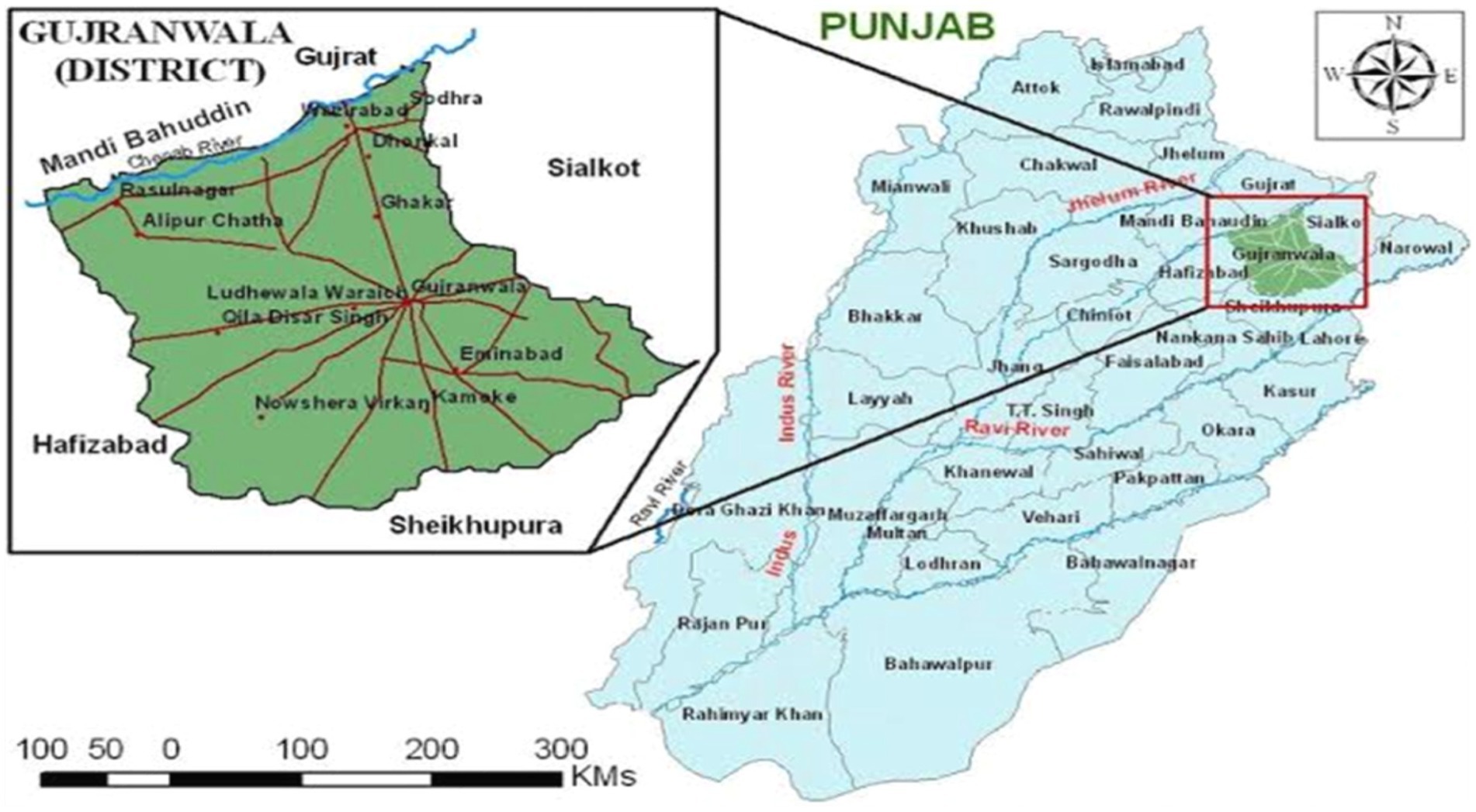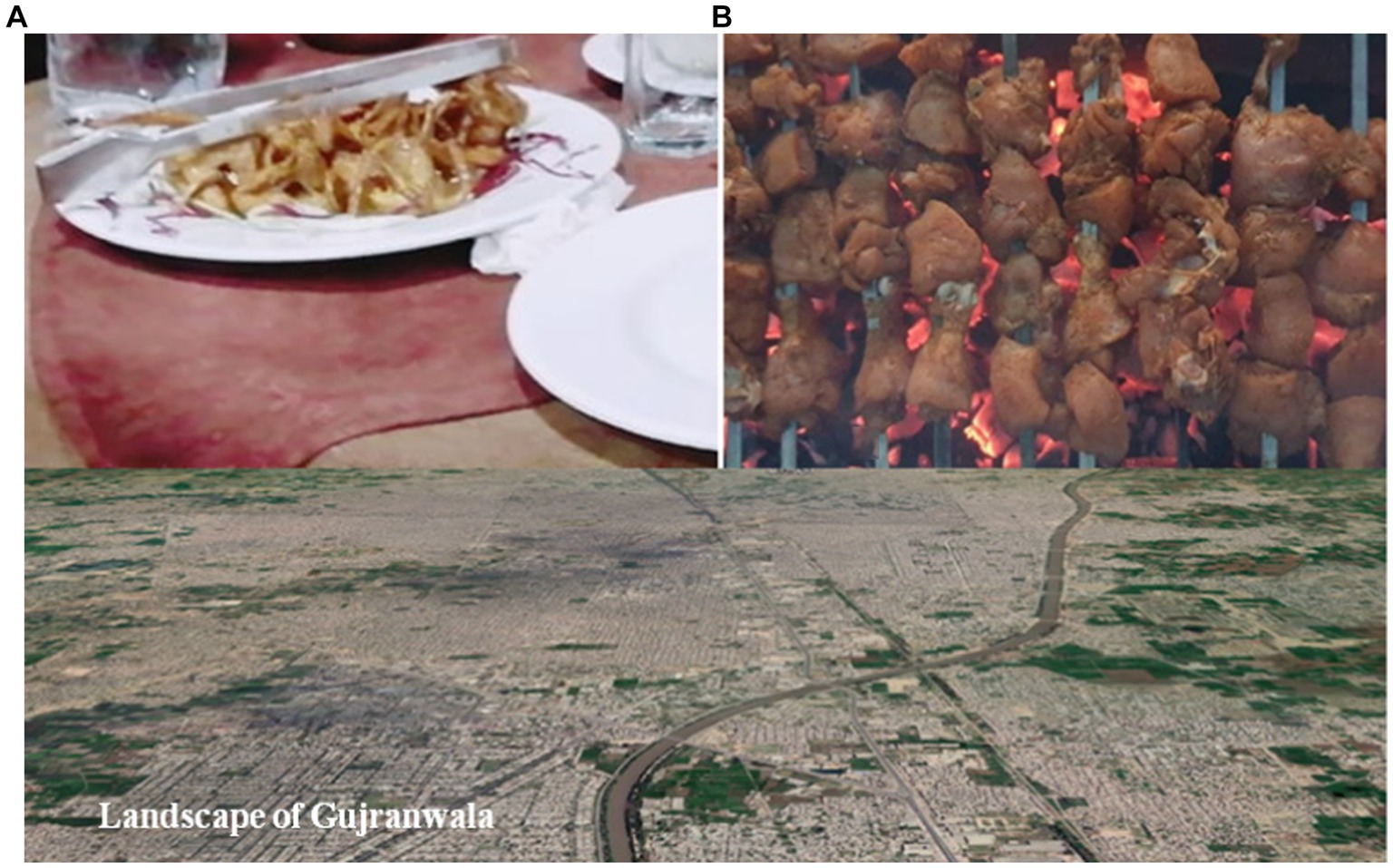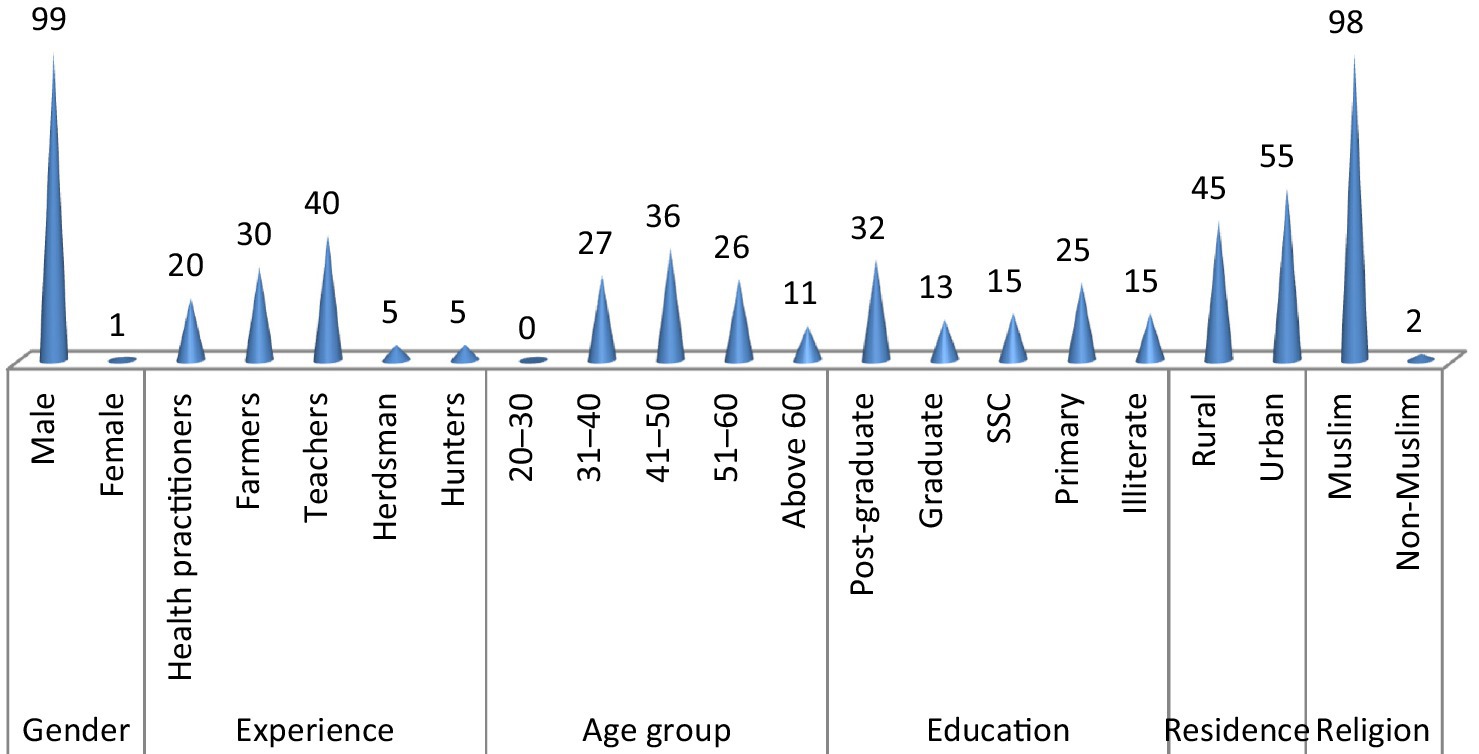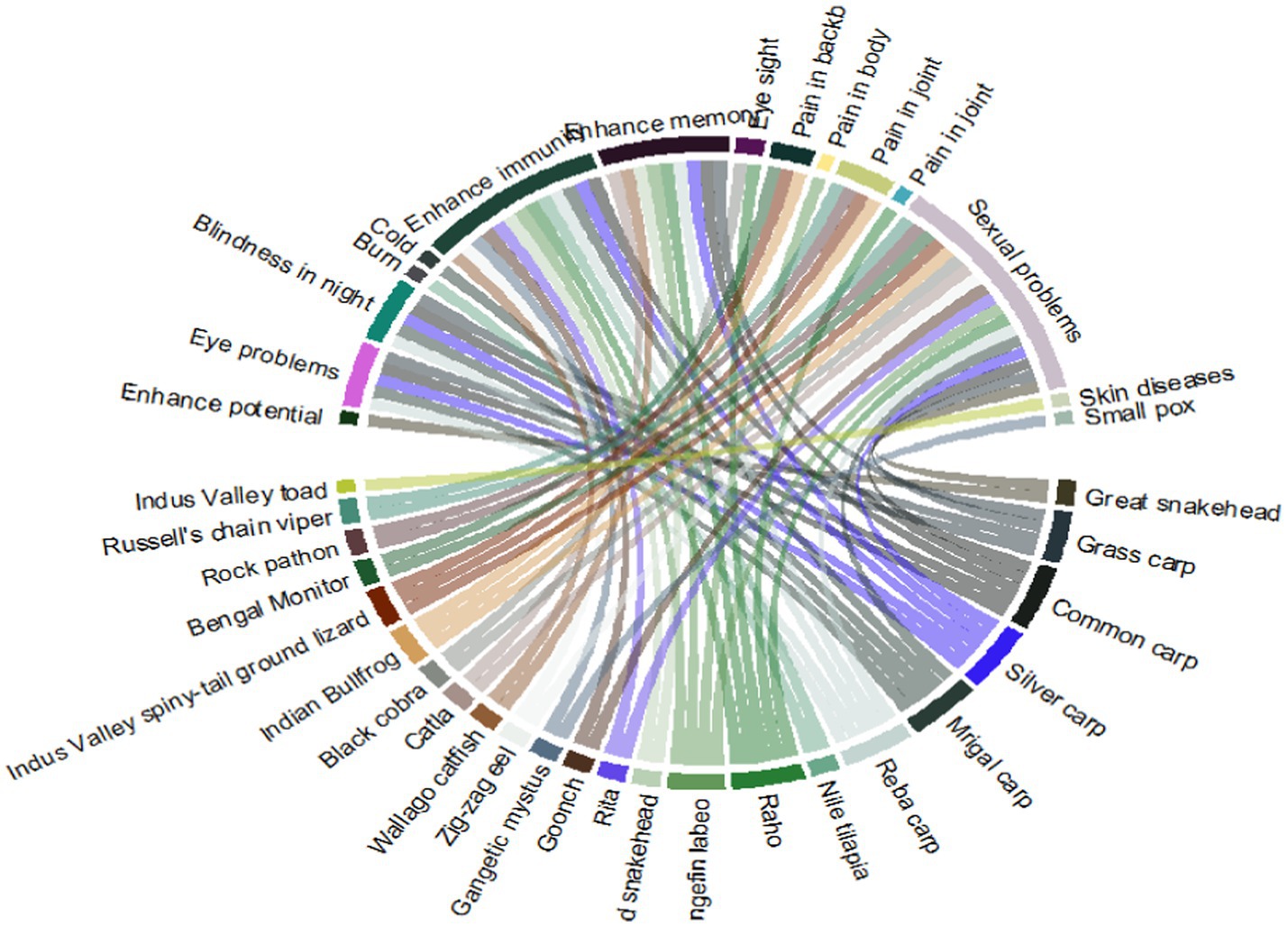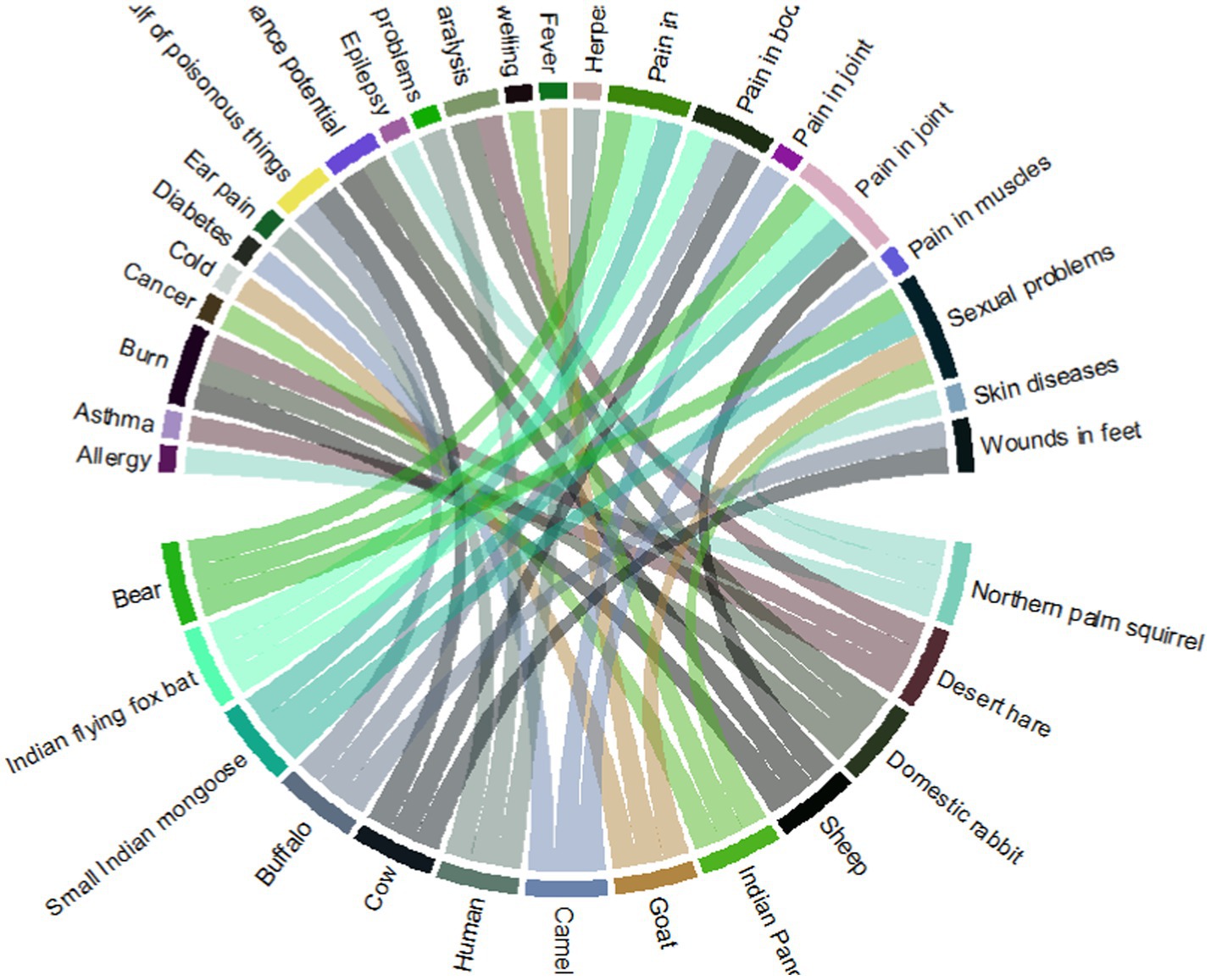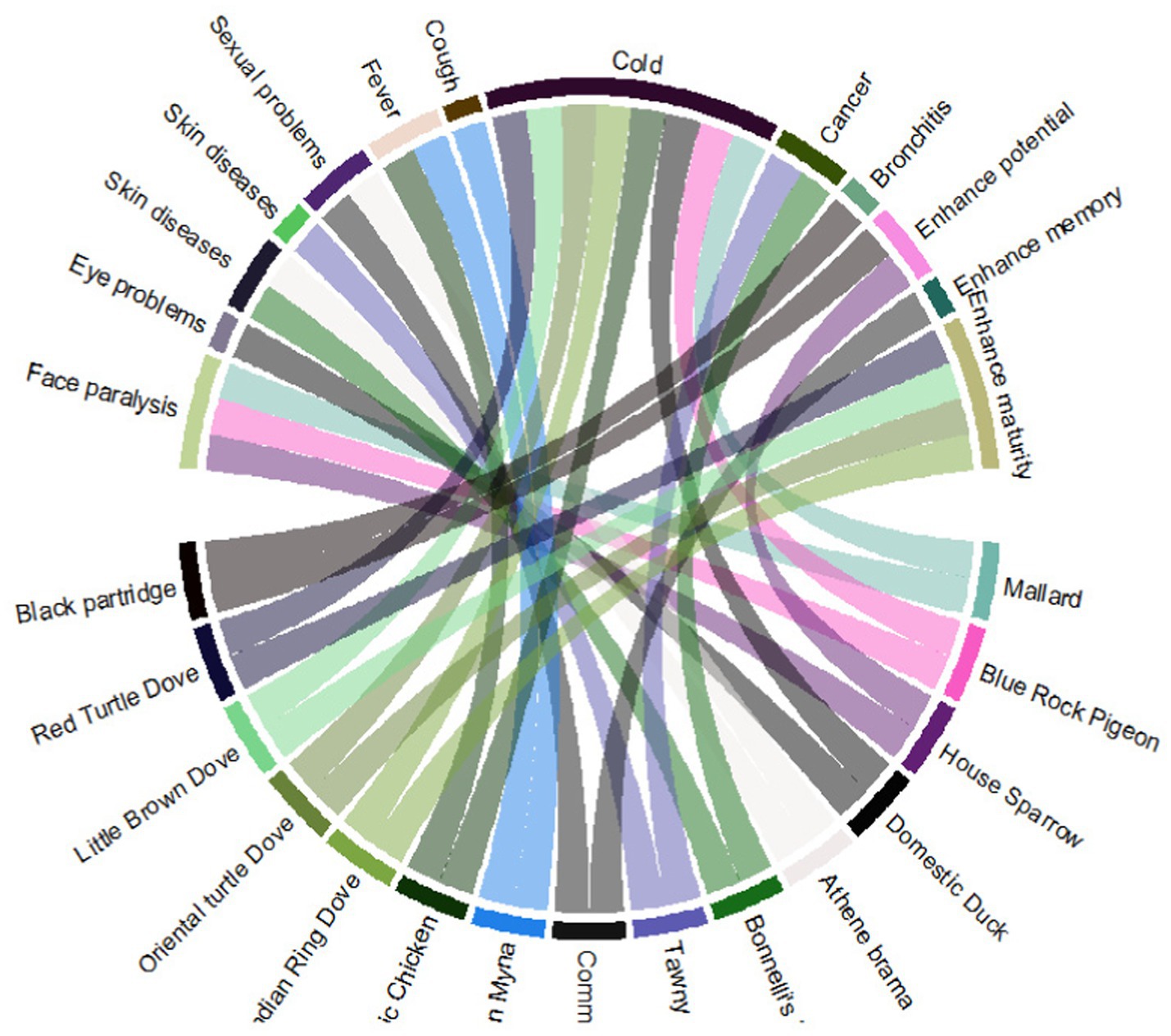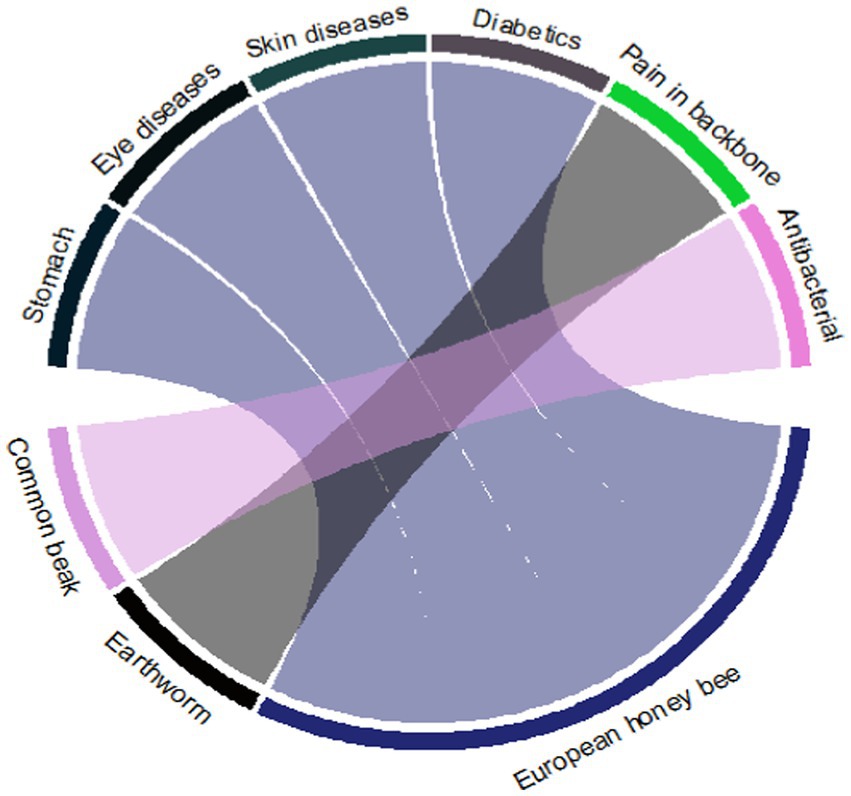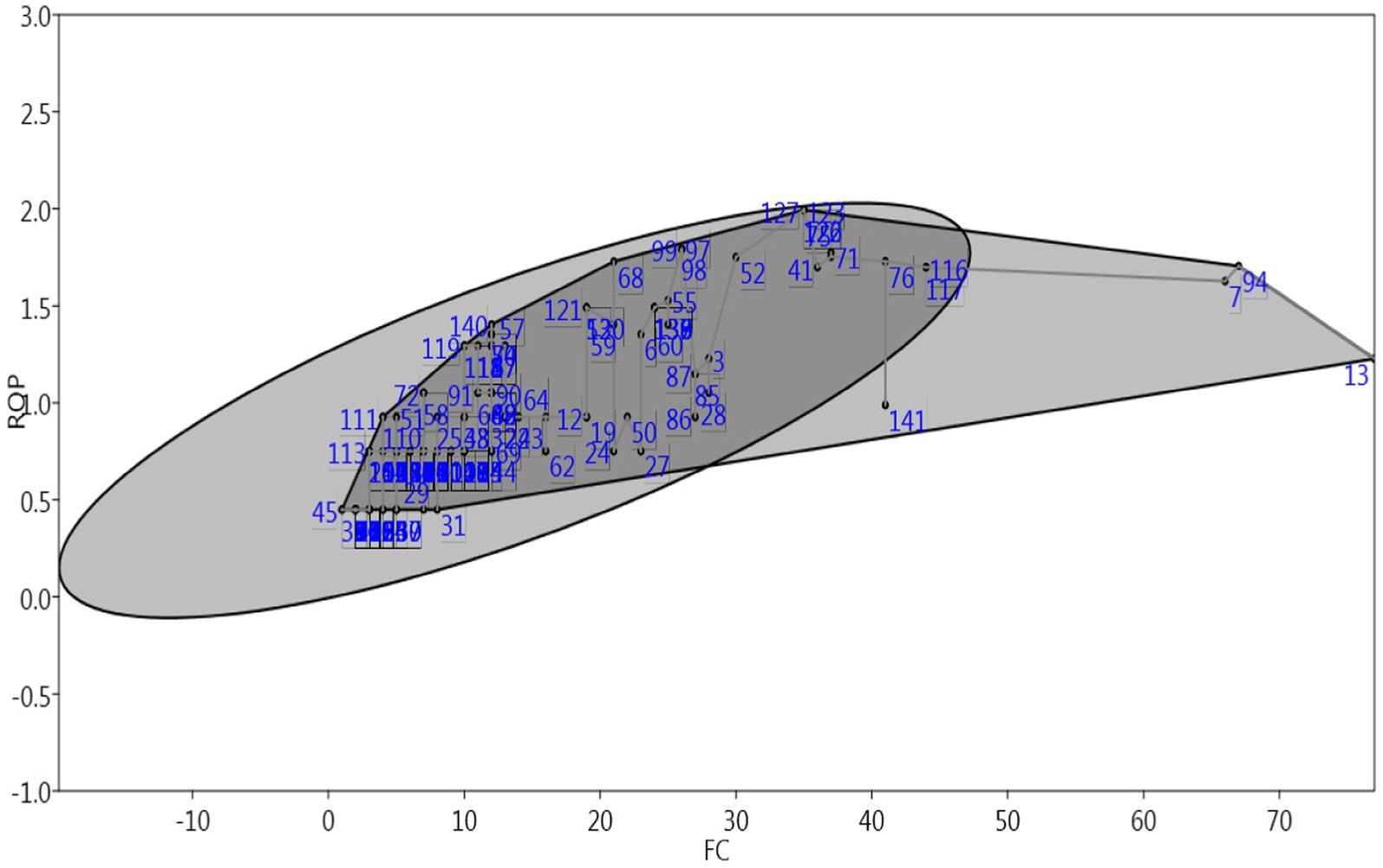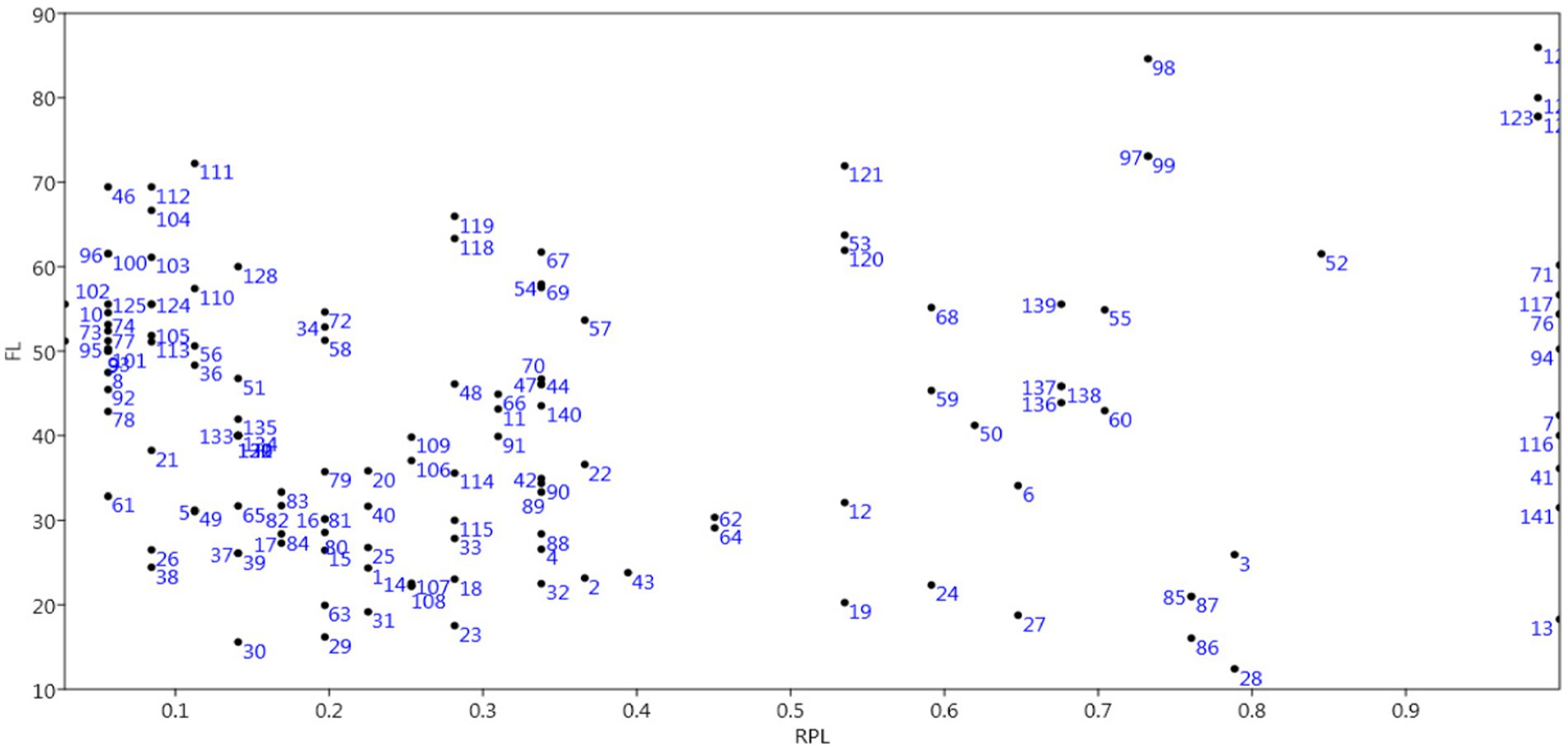- 1Institute of Zoology, University of the Punjab, Lahore, Pakistan
- 2Institute of Forest Sciences, The Islamia University of Bahawalpur, Bahawalpur, Pakistan
- 3Department of Zoology Wildlife and Fisheries, University of Agriculture Faisalabad, Faisalabad, Pakistan
- 4Department of Zoology, Wildlife and Fisheries, University of Agriculture Faisalabad, Faisalabad, Pakistan
- 5Department of Zoology, Shah Abdul Latif University, Khairpur, Sindh, Pakistan
- 6Department of Zoology, University of Sialkot, Sialkot, Punjab, Pakistan
- 7Department of Zoology, University of Lahore, Sargodha, Pakistan
- 8Department of Botany, Women University of Azad Jammu and Kashmir Bagh, Bagh, Pakistan
- 9Department of Botany, University of Gujrat, Gujrat, Punjab, Pakistan
- 10Department of Ethnobotany, Institute of Botany, Ilia State University, Tbilisi, Georgia
- 11Alpine Institute of Management and Technology, Dehradun, Uttarakhand, India
- 12Staatliches Museum Für Naturkunde, Karlsruhe, Germany
- 13Department of Environment Sciences, COMSATS University Islamabad, Abbottabad, Pakistan
- 14Department of Plant Production, College of Food & Agriculture Sciences, King Saud University, Riyadh, Saudi Arabia
- 15Department of Food Science, Faculty of Agriculture, Damietta University, Damietta, Egypt
Introduction: The utilization of fauna and fauna-based byproducts in ethnomedicinal usages has been a longstanding human activity, practiced across various cultures worldwide. This study focuses on investigating the utilization of animal-based traditional medicine by the people of Pakistan, specifically in the Gujranwala area.
Methods: Data collection took place from January to September 2019 through interviews with local communities. Ethnomedicinal applications of animal products were analyzed using several indices, including Relative Frequency of Citation (RFC), Relative Popularity Level (RPL), Folk Use Value (FL), and Relative Occurrence Percentage (ROP).
Results: The study identified the use of different body parts of 54 species of animals in treating various diseases and health issues. These include but are not limited to skin infections, sexual problems, pain management (e.g., in the backbone and joints), eyesight issues, immunity enhancement, cold, weakness, burns, smallpox, wounds, poisoning, muscular pain, arthritis, diabetes, fever, epilepsy, allergies, asthma, herpes, ear pain, paralysis, cough, swelling, cancer, bronchitis, girls’ maturity, and stomach-related problems. Certain species of fauna were noted by informers with high “frequency of citation” (FC), ranging from 1 to 77. For instance, the black cobra was the most frequently cited animal for eyesight issues (FC = 77), followed by the domestic rabbit for burn treatment (FC = 67), and the Indus Valley spiny-tailed ground lizard for sexual problems (FC = 66). Passer domesticus and Gallus gallus were noted to have the highest ROP value of 99.
Discussion: The findings of this study provide valuable preliminary insights for the conservation of fauna in the Gujranwala region of Punjab, Pakistan. Additionally, screening these animals for medicinally active compounds could potentially lead to the development of novel animal-based medications, contributing to both traditional medicine preservation and modern pharmaceutical advancements.
1 Introduction
Zootherapy is described as the use of animal or animal-derived products to treat human ailments (1). The utilization of fauna with therapeutic characteristics is still a popular practice across the world (2). Zootherapy methods and materials are used in both folk and modern medicine to treat different kinds of sicknesses (3–7). It has been found that over 13% of the medications used in traditional Chinese medicine are derived from fauna. In Ayurvedic medicine, faunal products make up 15–20% of the medications. More than 111 medications in Tibetan medicine contain fauna-based components (8–10).
Many communities are rapidly losing ethnomedicinal expertise, making it increasingly necessary to capture this information before it is lost (1, 11–17). The utilization of fauna and fauna-based yield in folk therapy has been under-documented, most likely due to the dominance of plants in folk medical systems (18, 19). Pakistan has a rich fauna diversity, including 668 species of birds (20), 195 species of mammals (21), 24 species of amphibians (22), and 195 species of reptiles (23).
Gujranwala has a diverse range of fauna and biodiversity. This region, with its plains and different ecosystems, is home to an amazing variety of wildlife. Dominant avian fauna is documented in Gujranwala, i.e., Acridothere ginginianus, Acridothere tristis, Apus affinis, Athene brama, Bubulcus ibis, Cercomela fusca, Columba livia, Corvus splendens, Egretta garzetta, Hirundo rustica, Hoplopterus indicus, Milvus migrans migrans, Nectarinia asiatica, and Passer domesticus (24), while important mammalian fauna of the area is reported as, i.e., Suncus etruscus, Funnambulus pennantii, Rattus rattus, Mus musculus, Herpestes javanicus, and Herpestes edwardsi (25–27), and more than 30 species of freshwater are documented along Gujranwala (28), and prominent herptiles are Saara hardwickii, Varanus bengalensis, Duttaphrynus stomaticus, Hemidactylus flaviviridis, Hoplobatrachus tigerinus, Aspideretes gangeticus, Lissemys punctate, Calotes versicolor, and Eryx johnii (29).
Knowing the conservation and management of biocultural systems requires ethnozoological study. Traditional usages of fauna species, e.g., food (30–37), medicine (32, 38–42), trade (43), etc., can endorse attitude that aids in the conservation of these animals; however, if they are practiced in an unsustainable manner or are influenced by economic and political factors, they may have a negative impact on or even endanger these animals. Local populations’ usage of animal species in traditional medicine and for cultural purposes must be evaluated in connection to other issues such as climate and habitat changes (44, 45). There is a global need to identify innovative techniques to cope with the current catastrophe of loss of biodiversity (46), and ethnozoology gives crucial insights into local community practices, allowing conservation efforts to successfully collaborate with resource managers to enhance the overall veracity of biological structures (47, 48). A number of studies have been conducted to date that has documented the use of animal parts in traditional medicine in various areas of Pakistan (31, 32, 49–61); however, ethnomedicinal applications of animals in Gujranwala have never been described. This research on the medical applications of fauna by the people of Gujranwala district in Pakistan is part of a larger plan to record the usage of fauna by local populations across Pakistan (18, 29, 62–64). The research on the ethnopharmacological uses of fauna among the inhabitants of central Punjab, Pakistan, aims to investigate and describe traditional understandings and methods of using local animal resources for medicinal reasons in this area. By conducting an in-depth inquiry into the fauna-based remedies used by communities of indigenous peoples, the study hopes to contribute to the preservation of traditional healing practices, shed light on the possible medicinal qualities of these animals, and provide insights for the conservation of biodiversity.
2 Materials and methods
2.1 Study site and climate
Gujranwala is the city and capital of Gujranwala Division, Punjab, Pakistan. It is also known as the “City of Wrestlers.” Gujranwala is Pakistan’s fifth-most populous city. Founded in the eighteenth century, Gujranwala is a relatively modern town compared to other nearby old cities in northern Punjab (Figure 1). The people of the area like to eat meat. The coordinates of Gujranwala are 32°9′24″N 74°11′24″E. Gujranwala has a hot, semi-arid climate. During the summer (June to September), the temperature reaches 40 °C. The coldest months are typically November through February, when temperatures can dip to an average of 5°C. During the other months, the average rainfall is approximately 25 mm. There is very little rain from October to May (Figures 2A,B).
2.2 Data collection
Semi-structured interviews and questionnaires were collected from 100 respondents (i.e., traditional health practitioners, farmers, teachers, hunters, and herdsmen). We selected random respondents from the community who have knowledge about traditional therapy. Respondents were chosen based on their ethnomedicinal and ethnocultural recognition of the customary remedial and societal value of herptiles, fish, animals, and fowl. Birds were identified using field guides, “The Birds of Pakistan.” Data were statistically analyzed using five indices, including (i) the “fidelity level” (FL), (ii) the “relative popularity level” (RPL), and (iii) “rank order priority.”
2.3 The Fidelity level
FL was analyzed with the help of a formula as follows (65):
where “Np” = number of respondents with vital chronic diseases for certain breeds of animals; FC = frequency of citation for ethnocultural utilization of specific creatures.
2.4 The relative popularity level
RPL was described previously by Friedman et al. (66); creatures were separated into two gatherings, for example, (i) “famous” and (ii) “disagreeable.” (i) Popular creatures are those species that were expressed for the greater part of the most extreme recurrence of reference (FC). (ii) The left-over creatures were recorded as disagreeable. While for famous (creature species) an even line was non-existent specifically, the normal numeral of employments per creature is free of the recurrence of reference (FC), who perceives the creatures; along these lines, the normal numeral of employments of mainstream creature animal varieties does not improve with the addition to recurrence of reference, who refers to the creature species for any clinical use. For the mainstream creature species, the RPL was set at 1. For creature species in disliked gatherings, the overall notoriety level is under 1.0.
2.5 Rank order priority
ROP is utilized to group the fauna species (66, 67) and was examined using the following formula:
3 Results and discussion
3.1 Informant selection for ethnozoological data collection
During the years 2018–2020, ethnozoological information was gathered; prior to the data collection, a reconnaissance survey was conducted to ensure accessibility across the study area. Using the snowball technique, we collected the traditional endemic knowledge using semi-structured questionnaires followed by group discussions. The informants selected were mostly from urban (55%). Furthermore, the selected informants were classified into different professions and age groups. The maximum number of informants were educated (92.9%). Upon data collection, men showed ascendency over women due to cultural and religious limitations. Women are not allowed to talk with strangers due to religious and social norms, and they are usually involved in house chores. The complete details can be found in Figure 3. It is documented that older people have more insights about traditional knowledge as compared with younger people, and it is also noted that uneducated and less educated people have more reliance on traditional knowledge as compared with highly educated people.
3.2 Taxonomy and ethnozoological inventory
In the ethno-scientific domain, we documented a total of 54 species used in Gujranwala, Pakistan, classified into different categories, i.e., herptiles (n = 7), fish (n = 16), mammals (n = 13), birds (n = 15), and invertebrates (n = 3). The complete inventory is provided in Table 1. The maximum usage of the fish species in the region can be attributed to the presence of the two important rivers (Ravi and Chenab) inhabiting varieties of fish fauna; also, the locals have a potential traditional knowledge of fish utilization.
Upon interpreting the results, it was revealed that different body parts of the documented species were employed against a variety of diseases. The most frequently used parts were meat (33%), followed by fat (30%), and brain (16%; Figures 4A–C).
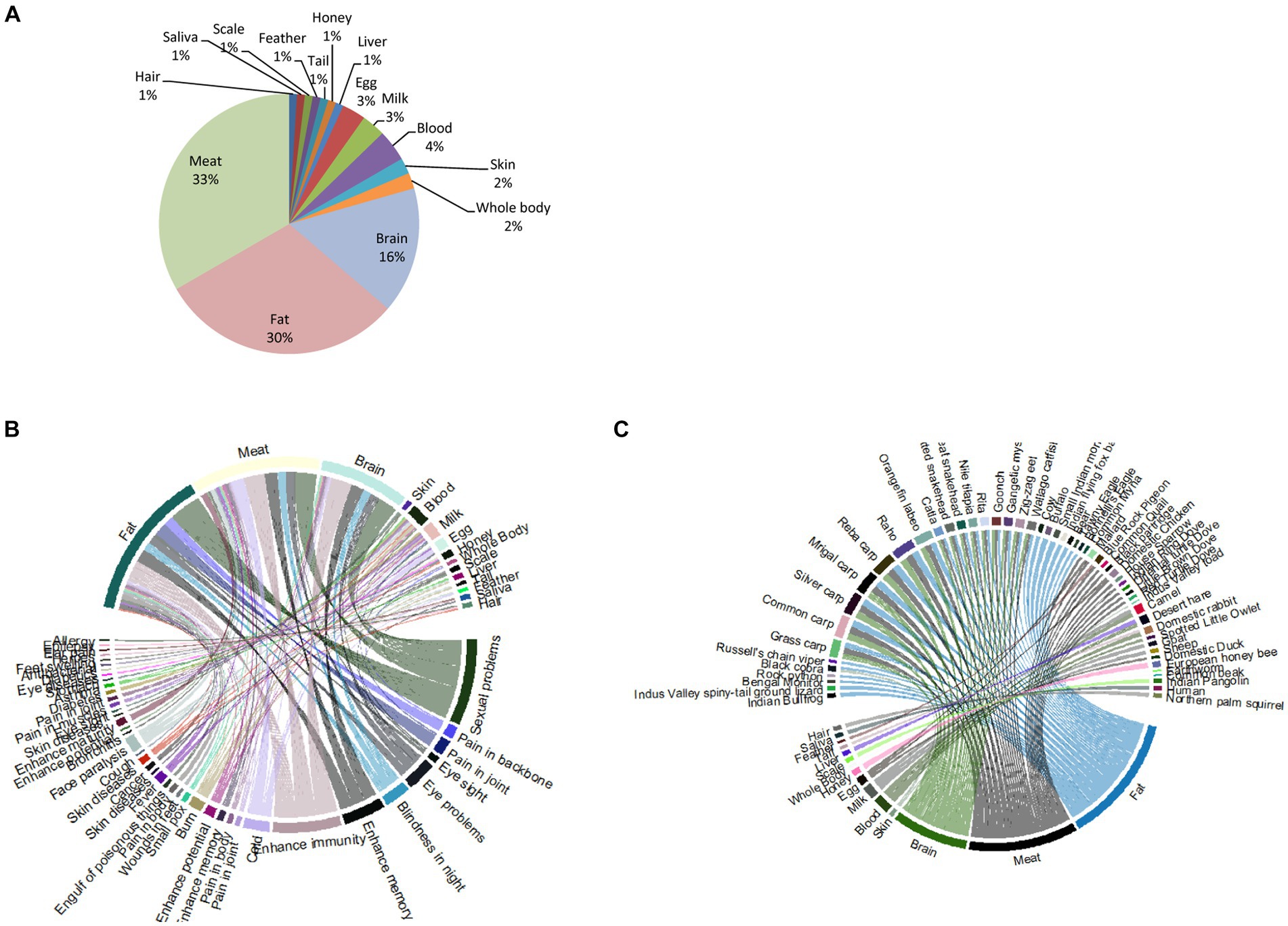
Figure 4. (A) Percentage of different body parts of fauna used to treat a variety of diseases in the study area. (B) The body parts are used to treat diseases. (C) Ethnopharmacological uses of body parts of animal species in the study area.
The fat of animals is the second most consumed body part of animals. The fat of 31 species of animals, i.e., Indian Bullfrog, Indus Valley spiny-tail ground lizard, Bengal monitor, rock python, black cobra, Russell’s chain viper, grass carp, common carp, silver carp, mrigal carp, Reba carp, raho, Orangefin labeo, catla, spotted snakehead, great snakehead, Nile tilapia, Rita, goonch, Gangetic mystus, zig–zag eel, wallago catfish, cow, buffalo, small Indian mongoose, Indian flying fox bat, bear, tawny eagle, and Bonelli’s eagle, is used to treat wounds in feet, small pox, skin diseases, sexual problems, pain in joints, pain in body, pain in backbone, fever, eyesight and eye problems, enhance potential, memory, and immunity, engulf of poisonous things, cold, cancer, burn, and blindness in the night (Figures 4A,B).
Similarly, the brain of animal species, i.e., grass carp, common carp, silver carp, mrigal carp, Reba carp, raho, Orangefin labeo, catla, spotted snakehead, great snakehead, Nile tilapia, Rita, goonch, Gangetic mystus, zig–zag eel, and wallago catfish, is used to treat small pox, sexual problems, pain in joints, pain in the body, eyesight and eye problems, enhance potential, memory, and immunity, cold, burn, and blindness at night (Figures 4A,B).
Similarly, the skin of animal species, i.e., the Indus Valley toad and black cobra catfish, is used to cure skin diseases, sexual problems, and eyesight, while the blood of camel, desert hare, domestic rabbit, and spotted little owlet is used to cure pain in muscles, pain in joints, diabetes, asthma, burns, face paralysis, burn, enhance potential, sexual problems, and skin diseases. However, the milk of camel, goat, and sheep is used to treat pain in muscles, pain in joints, diabetes, sexual problems, cold, fever, burn, and enhance potential (Figures 4A,B).
3.3 Ethnomedicinal use of herptile and fish
In the present study, we found that the local people use the herptiles and fish for different ailments. Sexual problems were found to be treated by most of the species, followed by “enhanced immunity” (Figure 5).
3.4 Ethnomedicinal use of mammals
The present study revealed that 23 diseases were treated by the documented mammals (Figure 6). The maximum use of the species to treat cold is due to the belief that the meat has the potential to overcome cough and cold. Also, meat is rich in protein, which in turn provides body strength.
3.5 Ethnomedicinal use of aves and invertebrates
In the present study, 15 birds were reported to treat 13 diseases. The most frequent diseases treated were “cold” followed by “enhanced maturity” and “face paralysis” (Figure 7). Only three invertebrate species were documented, i.e., European honey bee, earthworm, and common beak, to treat different diseases. The European honey bee was recorded for ascendancy as the said species treated a maximum number of diseases (stomach, eye diseases, skin diseases, and diabetics), contrary to the other two invertebrates (Figure 8).
3.6 Frequency of citation
In the present study, different species were reported by a different number of informants. The FC ranged between 1 and 77 (Table 1; Figure 9). The highest value of FC (77) was obtained for Black cobra (for eyesight), followed by domestic rabbit (for burn) with FC = 67, and Indus Valley spiny-tail ground lizard (for sexual problems; FC = 66). The lowest value of FC = 1 was recorded for the Orangefin labeo (to enhance memory) and Reba carp (for eye problems).
3.7 The Fidelity level
According to Altaf et al. (18), FL is used for the identification of the species that are most preferred in a region by the local inhabitants for curing different diseases. Any species with the maximum medicinal uses in a region is known to have the highest fidelity level (54). A complete list of the fidelity levels of the documented species is provided in Table 1. The highest FL (100; Figure 10) was registered for Orangefin labeo, Labeo calbus (for enhanced memory); Reba carp, Cirrhinus reba (for eye problems); domestic chicken, Gallus (for fever and cold); house sparrow (to enhance potential and face paralysis); followed by cows (90.48) to treat pain in the body and Ovis aries (84.62) to treat burns, enhance potential, and to treat pain in joints. The lowest FL (8.70) was recorded for Hypophthalmichthys molitrix (to enhance memory).
3.8 The relative popularity level
The relative popularity level (RPL) of the species can be seen in Table 1. We grouped the species into two categories (popular and unpopular; Figure 9). Species with RPL 1 are considered to be popular, and these include species, such as Indus Valley spiny-tail ground lizard, Uromastyx hardwickii; Black cobra, Naja naja naja; Raho, Labeo rohita; Buffalo, Bubalus bubalis; Camel, Camelus dromedaries; Goat, Capra aegagrus hircus; Domestic rabbit, Oryctolagus cuniculus; Blue Rock Pigeon, Columba livia; and Common beak, Libythea lepita.
3.9 Rank order priority
Rank order priority (ROP) is employed to assign an appropriate grade to the documented species with different FL values. The calculated ROP values for each species are presented in Table 1. Passer domesticus and Gallus gallus were the species with the highest ROP (99), followed by Ovis aries (62), Camelus dromedaries (59), Bubalus bubalis (57), Channa punctata (56), Labeo rohita (50), and Uromastyx hardwickii (42; Table 1; Figure 7).
4 Discussion
Meat contains nitrogenous and non-nitrogenous substances, water, lipids, sodium, magnesium, glycogen, lactic acid, potassium, iron, calcium, phosphorus, and chlorine (68, 69). Meat composition varies owing to the effects of many environmental elements and internal characteristics such as animal species, diet, muscle, breed, and sex (70). Poultry, cattle, sheep, goat, fish, and pork are the most common meat sources globally. However, in a few nations, particularly in arid and semi-arid regions, camel meat is renowned as the primary source of animal protein that equals, and in some cases exceeds, the commercial importance of other meats (31, 71–74). Bones include up to 95% elastic protein, collagen fibers, and inorganic minerals such as calcium and phosphate, which help to prevent bone fracture. Ethnozoologists discovered that various species of animals, including the Indian gagata, horse, goat, fruit bat, deer, crow, crab-eating macaque, common carp, cinereous vulture, and alpine musk deer, were used to treat a variety of ailments, including wound healing, digestion, heart strength, ear ache, lumbago, skin, chest pain, and urine problems (18, 29, 55, 75–84).
Nanoparticles can operate as carriers for fish oil ingredients (85), preserving them from degradation in the gastrointestinal system and allowing for regulated release at particular locations throughout the body. Several forms of nanoparticles, including liposomes (86), nanoemulsions (87), and polymeric nanoparticles (88), have been investigated for encapsulating fish oil or its active components, such as eicosapentaenoic acid (89) and docosahexaenoic acid (90). Docosahexaenoic acid has received a lot of interest in the field of nanomedicine because of its potential health advantages and therapeutic qualities. These fatty acids play important roles in a variety of physiological processes, including cancer (91), inflammation (92), and diabetic problems (93). Omega-3 fatty acids in vertebrate fats have been shown to reduce inflammation. Ethnobiologists discovered that lipids are utilized to treat neurological disorders, atherosclerosis, thrombosis, and the effects of aging (32, 94–96). The previous published data showed that fats of various animals species, i.e., wild boar (Sus scrofa), turtle (Aspideretes sp.), streaked prochilod (Prochilodus platensis), sheep (Ovis sp.), mongoose (Herpestes sp.), bat (Pteropus sp.), lizard (Hemidactylus sp.), Irrawaddy, dolphin (Orcaella brevirostris), Indus Valley spiny-tail ground lizard (Saara hardwickii), Indian rock python (Python molurus), Indian flap-shelled turtle (Lissemys punctata andersoni), Indian bullfrog (Hoplobatrachus tigerinus), horse (Equus sp.), Himalayan Serow (Capricornis thar), hen (Gallus sp.), jackal (Canis sp.), hare (Lepus sp.), green pond frog (Euphlyctis Hexadactylus), goat (Capra aegagrus hircus), deer (Cervidae), cow (Bos sp.), common leopard gecko (Eublepharis macularius), cat (Felis sp.), buffalo (Bubalus bubalis) and Asiatic black bear (Ursus sp.), are used to cure different ailments such as wounds and injuries, toothache (97), wound skin burn and crack, pain in back (26, 98), sexual stimulant (18, 26, 29, 82, 97, 99, 100), rheumatism (26, 82), pain in muscles (82, 83), menstruation problem (84), asthma (26, 82, 83), impotency (18, 29), head pain (98), erysipelas (83), ear disease, wounds (84, 97), cancer (29), asthma, wart (26, 97), arthritis (26), anemia, fever, paralysis (26, 83), allergy, wound, skin disease (26, 76, 83), allergy, typhoid, ear infection (82, 101), and pain in joints (100).
Milk is one of the most important and oldest foods. Mammalian species’ milk consists of lactose, ash, fats, proteins, solids, and water (102–111). Milk of different mammalian species, i.e., Panthera tigris, Ovis aries, Muntiacus muntjak, Homo sapiens, Equus caballus, Equus asinus, Equus africanus, Capra hircus, Capra aegagrus, Camelus dromedaries, Bubalus bubalis, and Bos taurus, is used to cure different sicknesses, i.e., enhance immunity, wound, whooping cough, skin burn, sexual power, red eyes, pain, muscular pain, jaundice, invigorative, hiccup, hepatitis, headache, gastritis, eye, diabetes, cough, cold, catarrh, and arthritis (7, 18, 26, 82, 84, 112–126).
The egg is a good source of protein and nutrients for people and a source of chemicals and elements such as “phosphorus,” “selenium,” “amino acid,” “iron, vitamins A, B6, B12,” and “folic acid.” Asthma, high blood pressure, breast cancer, bronchitis, burns, CNS, cold, diabetes, eye diseases, fever, hemorrhoids, indigestion, jaundice, mental disorders, night blindness, nourishment, sinusitis, sprains, tooth, weak eye side, weakness, and weight loss are all treated with eggs (18, 26, 37, 114, 115, 119–121, 124, 127–138). The egg has components that provide the best environment for an embryo’s development and growth. Except for vitamin C, it is a major source of important nutrients for humans. Eggs are an incredibly tasty and healthy item that can be utilized in a variety of ways (37).
Feather is utilized as a biomaterial since it is inexpensive and environmentally beneficial. Feathers are made up of “α-helix” and “β-sheet.” Bird feathers are utilized for decoration and as toys. Feathers of various species are used in traditional medicine, e.g., Phalacrocorax brasilianus, Nothura boraquira, Meleagris gallopayo, Coryus splendens, Corythaeola cristata, Coragyps atratus, Columba livia, and Ceryle rudis, to treat alcoholism, asthma, cough, cough, flu, headache, and typhoid (49, 82, 112, 113, 119, 121, 124, 133, 139–142). Feathers are used for a variety of purposes, such as antibacterial activity modification, biosorbents, cell viability enhancement, cosmetic micro- and nanoparticles, and wound dressing in industry. Graphene Oxide is utilized as a bio-composites, bio-fertilizer, biomaterial, feeding supplement, bioplastic, electrode material, fire-resistant substance, leather processing, paper formation, protein for ruminants, regenerated fibers, textile fibers, thermoplastic films, tissue reformation, and wound healing (49, 143–164).
Honey is composed of amino acids (165, 166), minerals (167), organic acids, phenolic compounds (168), solid particles (169), sugars (170), vitamins (171), water, proteins, disaccharides (172–174), and volatile compounds (175). Honey is utilized as a therapy in folk medicine to heal acidity, obesity, allergy, Alzheimer’s disease, asthma, atherosclerosis, burn, cancer, cold, cough, diabetes mellitus, diarrhea, expectorant, eye infection, gastritis, hypertension, influenza, migraine, skin, snake-bite, spleen, throat pain, tonsils, toothache, and urinary system (7, 18, 30, 81, 82, 84, 98, 115–117, 119, 120, 123, 124, 126, 137, 176–183). Honey is also used in nanomedicine to heal diverse sicknesses and behaves as oxidative stress, heart, blood pressure, anti-proliferative, antioxidant, anti-inflammatory, anti-fungal endophthalmitis, anti-diabetic, anti-cataract, antibiotic, antibacterial, and anti-apoptosis (184–199). Many fauna species have been shown to be quite adaptable in their applications. The maximum relative significance levels may indicate that animals are easily accessible and affordable (200–202).
5 Conclusion
The folklore animal-based medicinal concept of Gujranwala communities indicates that people have a strong link with ecology. The ethnopharmacological benefits of the fauna in Gujranwala were documented for the first time. In addition, 54 fauna species are employed to treat various human ailments. Different body parts of animals (viz. skin, fat, brain, meat, milk, blood, hair, saliva, flesh, liver, scale, tail, egg, feather, honey, and whole body) are used to treat various diseases such as skin infection, sexual problems, pain in the backbone, joint pain, eyesight, night blindness, enhance immunity and memory, cold, weakness, body pain, burn, smallpox, wounds in feet, engulf of poisonous things, pain in muscles, arthritis, diabetes, fever, epilepsy, allergy, asthma, burn, herpes, ear pain, paralysis, cough, swelling, cancer, bronchitis, girls maturity, stomach, and antibacterial infections. The present results provide data that may be constructive for the conservation of fauna in the district of Gujranwala, Punjab, Pakistan. Screening of bioactive materials and “in vivo” and/or “in vitro” studies of the zoological activities of the species with the highest FC, FL, RPL, and ROP, may be significant for wild animal-based novel medications. Due to financial constraints, the local population lives in isolated, hilly villages that are far from urban areas, primarily involved in agricultural labor, home-based businesses, and livestock rearing. The locals heavily rely on medicinal flora to meet their basic medical needs. While nearby regions such as Malakand, Dir Lower, Chitral, and Swat have been thoroughly investigated for their medicinal plants, this study focuses specifically on Dir Upper. This investigation supported the theory that the local indigenous knowledge would differ significantly from its surroundings. Notably, 80% of people in developing nations rely on herbal health remedies. The primary healthcare needs are met in large part by local healers. Medicinal plants with significant UV protection were found to protect the studied area’s biodiversity. Unfortunately, anthropogenic practices, such as overharvesting, overpopulation, and grazing, endanger regional biodiversity. To stop the impending extinction of medicinal plants in the study area, initiatives for cultivating these species must be implemented immediately. This strategy will lessen the risks brought on by human activity and maintain the availability of vital plant resources for future generations.
Data availability statement
The original contributions presented in the study are included in the article/supplementary material, further inquiries can be directed to the corresponding authors.
Author contributions
AK: Conceptualization, Data curation, Formal analysis, Methodology, Writing – original draft. MA: Conceptualization, Investigation, Methodology, Project administration, Writing – original draft. TH: Project administration, Supervision, Validation, Writing – review & editing. AA: Resources, Validation, Writing – review & editing. Z-nM: Resources, Validation, Writing – review & editing. AH: Data curation, Validation, Writing – review & editing. SA: Data curation, Writing – original draft. US: Data curation, Investigation, Writing – review & editing. MSA: Supervision, Validation, Visualization, Writing – review & editing. MM: Funding acquisition, Project administration, Resources, Validation, Visualization, Writing – review & editing. MH: Validation, Methodology, Writing – review & editing. RB: Supervision, Validation, Visualization, Writing – review & editing. AMA: Conceptualization, Project administration, Supervision, Validation, Visualization, Writing – review & editing. MA-Y: Validation, Visualization, Writing – review & editing. HE: Validation, Visualization, Writing – review & editing. EM: Validation, Visualization, Writing – review & editing. MHH: Methodology, Data curation, Writing – original draft preparation, Writing – review and editing.
Funding
The author(s) declare that financial support was received for the research, authorship, and/or publication of this article. This work was supported by the Research and Innovations “Ministry of Education” in Saudi Arabia (IFKSUOR3-095-6).
Acknowledgments
The authors extend their appreciation to the Deputyship for Research and Innovations “Ministry of Education” in Saudi Arabia for funding this research (IFKSUOR3-095-6).
Conflict of interest
The authors declare that the research was conducted in the absence of any commercial or financial relationships that could be construed as a potential conflict of interest.
Publisher’s note
All claims expressed in this article are solely those of the authors and do not necessarily represent those of their affiliated organizations, or those of the publisher, the editors and the reviewers. Any product that may be evaluated in this article, or claim that may be made by its manufacturer, is not guaranteed or endorsed by the publisher.
References
1. Faiz, M, Adil, S, and Nawaz, A. Chemical composition, ethnopharmacological applications of animal biles-mini review. J Wildlife Ecol. (2022) 6:172–7.
2. Altaf, M. Assessment of avian and mammalian diversity at selected sites along river Chenab. Lahore, Pakistan: University of Veterinary and Animal Sciences (2016).
3. Costa-Neto, EM. Animal-based medicines: biological prospection and the sustainable use of zootherapeutic resources. An Acad Bras Cienc. (2005) 77:33–43. doi: 10.1590/S0001-37652005000100004
4. Holennavar, P. Use of animal and animal derived products as medicines by the inhabitants of villages in Athani taluka of Belagavi District. Karnataka Int J App Res. (2015) 1:437–40. doi: 10.1007/s10668-019-00404-6
5. Kassam, A. World resources 2000–2001: people and ecosystems: the fraying web of life. Washington, DC: World resources institute (2000) (2002). 389 p.
6. Lawal, O, and Banjo, A. Survey for the usage of arthropods in traditional medicine in southwestern Nigeria. J Entomol. (2007) 4:104–12. doi: 10.3923/je.2007.104.112
7. Lev, E. Traditional healing with animals (zootherapy): medieval to present-day Levantine practice. J Ethnopharmacol. (2003) 85:107–18. doi: 10.1016/S0378-8741(02)00377-X
8. Singh, V. A note on the use of wild animal organs in Tibetan medicine. Traffic India. Lodhi Estate, New Delhi: WWF (2000).
9. Still, J. Use of animal products in traditional Chinese medicine: environmental impact and health hazards. Complement Ther Med. (2003) 11:118–22. doi: 10.1016/S0965-2299(03)00055-4
11. Arif, U, Bhatti, KH, Ajaib, M, Wagay, NA, Majeed, M, Zeb, J, et al. Ethnobotanical indigenous knowledge of tehsil Charhoi, district Kotli, Azad Jammu and Kashmir, Pakistan. Ethnobot Res Appl. (2021) 22:1–24. doi: 10.32859/era.22.50.1-24
12. Arshad, F, Waheed, M, Harun, N, Fatima, K, Khan, BA, Fatima, K, et al. Indigenous farmer's perception about fodder and foraging species of semi-arid lowlands of Pakistan: A case study of district Kasur Pakistan. Taiwania. (2022) 67:510–23. doi: 10.6165/tai.2022.67.510
13. Bashir, SM, Altaf, M, Hussain, T, Umair, M, Majeed, M, Mangrio, WM, et al. Vernacular taxonomy, cultural and ethnopharmacological applications of avian and mammalian species in the vicinity of Ayubia National Park. Himalayan Region Biol. (2023) 12:609. doi: 10.3390/biology12040609
14. Haq, SM, Yaqoob, U, Majeed, M, Amjad, MS, Hassan, M, Ahmad, R, et al. Quantitative ethnoveterinary study on plant resource utilization by indigenous communities in high-altitude regions. Front Vet Sci. (2022) 9:944046. doi: 10.3389/fvets.2022.944046
15. Majeed, M, Lu, L, Anwar, MM, Tariq, A, Qin, S, El-Hefnawy, ME, et al. Prediction of flash flood susceptibility using integrating analytic hierarchy process (AHP) and frequency ratio (FR) algorithms. Front Environ Sci. (2023) 10:1037547. doi: 10.3389/fenvs.2022.1037547
16. Majeed, M, Tariq, A, Haq, SM, Waheed, M, Anwar, MM, Li, Q, et al. A detailed ecological exploration of the distribution patterns of wild Poaceae from the Jhelum District (Punjab). Pakistan Sustainability. (2022) 14:3786. doi: 10.3390/su14073786
17. Saeed, A, Umair, M, Altaf, M, Hussain, T, and Abbasi, AM. Ethno-veterinary medicines of South Punjab. Pakistan J Wildlife Ecol. (2022) 6:64–81.
18. Altaf, M, Umair, M, Abbasi, AR, Muhammad, N, and Abbasi, AM. Ethnomedicinal applications of animal species by the local communities of Punjab Pakistan. J Ethnobiol Ethnomed. (2018) 14:55. doi: 10.1186/s13002-018-0253-4
19. Alves, RR, and Rosa, IL. Zootherapy goes to town: the use of animal-based remedies in urban areas of NE and N Brazil. J Ethnopharmacol. (2007) 113:541–55. doi: 10.1016/j.jep.2007.07.015
25. Altaf, M. Assessment of avian and mammalian diversity at selected sites along river Chenab. Lahore-Pakistan: University of Veterinary and Animal Sciences (2016).
26. Altaf, M, Javid, A, Umair, M, Iqbal, KJ, Rasheed, Z, and Abbasi, AM. Ethnomedicinal and cultural practices of mammals and birds in the vicinity of river Chenab Punjab-Pakistan. J Ethnobiol Ethnomed. (2017) 13:1–24.
27. Altaf, M, Khan, AM, Umair, M, and Irfan, MMA. Status of wild birds and mammals in urban habitats of Gujranwala, Punjab Pakistan. Punjab Univ J Zool. (2012) 27:9–12.
28. Altaf, M, Javid, A, Khan, AM, Hussain, A, Umair, M, and Ali, Z. The status of fish diversity of river Chenab, Pakistan. J Animal & Plant Sci. (2015) 25:564–9.doi: 10.1186/s13002-017-0168-5
29. Altaf, M, Abbasi, AM, Umair, M, Amjad, MS, Irshad, K, and Khan, AM. The use of fish and herptiles in traditional folk therapies in three districts of Chenab riverine area in Punjab. Pakistan J Ethnobiol Ethnomed. (2020) 16:1–21. doi: 10.1186/s13002-020-00379-z
30. Altaf, M, and Umair, M. Diversity, distribution and medicinal importance of honeybees in the world-A review. J Wildlife Ecol. (2020) 4:130–41.
31. Haidar, R, and Bashir, SM. Chemical composition, traditional and modern uses of meat of animals-a review. J Wildlife Ecol. (2021) 5:47–55.
32. Ijaz, S, and Faiz, M. Chemical composition, folk and modern uses of fats and oil-a review. J Wildlife Ecol. (2021) 5:104–10.
33. Khoja, AA, Haq, SM, Majeed, M, Hassan, M, Waheed, M, Yaqoob, U, et al. Diversity, ecological and traditional knowledge of pteridophytes in the western Himalayas. Diversity. (2022) 14:628. doi: 10.3390/d14080628
34. Majeed, M, Bhatti, KH, and Amjad, MS. Impact of climatic variations on the flowering phenology of plant species in JHELUM district, Punjab Pakistan. Appl Ecol Environ Res. (2021) 19:3343–76. doi: 10.15666/aeer/1905_33433376
35. Majeed, M, Bhatti, KH, Pieroni, A, Sõukand, R, Bussmann, RW, Khan, AM, et al. Gathered wild food plants among diverse religious groups in Jhelum District, Punjab, Pakistan. Food Secur. (2021) 10:594. doi: 10.3390/foods10030594
36. Majeed, M, Tariq, A, Anwar, MM, Khan, AM, Arshad, F, Mumtaz, F, et al. Monitoring of land use–land cover change and potential causal factors of climate change in Jhelum district, Punjab, Pakistan, through GIS and multi-temporal satellite data. Landscape. (2021) 10:1026. doi: 10.3390/land10101026
37. Tariq, S. Chemical composition and traditional uses of eggs of different avian species-A review. J Wildlife Ecol. (2020) 4:45–50.
38. Akhtar, S. Antimicrobial effect of silver nanoparticles synthesized from skin of Laudakia agrorensis. J Wildlife Ecol. (2021) 5:176–85.
40. Habib, S. Antibacterial activity of biogenic synthesized silver nanoparticles using skin of Kashmir Nadi frog Paa barmoachensis. J Wildlife Ecol. (2022) 6:07–12.
41. Nazir, N. Biosynthesis of silver nanoparticles from skin of Hazara toad (Bufo melanostictus) and assessment of antibacterial activity. J Wildlife Ecol. (2021) 5:111–9.
42. Zainab, S. Antibacterial and antibiofilm activity of bull frog Hoplobatrachus tigerinus skin extract. J Wildlife Ecol. (2021) 5:32–7.
43. Khan, MSH, Ullah, S, Hamed, MH, and Altaf, M. A study of illegal wildlife trade and seizures in Pakistan. J Wildlife Ecol. (2020) 4:193–210.
44. Alves, RR. Relationships between fauna and people and the role of ethnozoology in animal conservation. Ethnobiol Conserv. (2012) 1:1–69. doi: 10.15451/ec2012-8-1.2-1-69
45. Alves, RRN, Silva, JS, da Silva, CL, and Albuquerque, UP. Ethnozoology and animal conservation. In: Ethnozoology Elsevier. (2018):481–96. doi: 10.1016/B978-0-12-809913-1.00025-9
46. Boivin, NL, Zeder, MA, Fuller, DQ, Crowther, A, Larson, G, Erlandson, JM, et al. Ecological consequences of human niche construction: examining long-term anthropogenic shaping of global species distributions. Proc Natl Acad Sci. (2016) 113:6388–96. doi: 10.1073/pnas.1525200113
47. Dickman, AJ. Complexities of conflict: the importance of considering social factors for effectively resolving human–wildlife conflict. Animal. (2010) 13:458–66. doi: 10.1111/j.1469-1795.2010.00368.x
49. Adil, S, and Tariq, S. Study of traditional and modern applications of feathers-a review. J Wildlife Ecol. (2020) 4:141–50.
50. Ali, A, Khan, MSH, and Altaf, M. Winter survey of birds at district of the Badin, Pakistan. J Wildlife Ecol. (2018) 2:11–22.
51. Altaf, M, Abbasi, AM, Umair, M, Amjad, MS, Muhammad, N, Iqbal, KJ, et al. The usage of freshwater fishes in cultural and folklore therapies among the people along river Jhelum, Punjab Pakistan. J Wildlife Ecol. (2021) 5:79–99.
52. Aslam, H, and Faiz, M. Ethnopharmacological and modern applications of milk of various mammalian species-a review. J Wildlife Ecol. (2020) 4:211–26.
53. Hassan, M, Haq, SM, Ahmad, R, Majeed, M, Sahito, HA, Shirani, M, et al. Traditional use of wild and domestic Fauna among different ethnic groups in the Western Himalayas—A cross cultural analysis. Animals. (2022) 12:2276. doi: 10.3390/ani12172276
54. Hassan, M, Haq, SM, Majeed, M, Umair, M, Sahito, HA, Shirani, M, et al. Traditional food and medicine: Ethno-traditional usage of fish Fauna across the valley of Kashmir: A western Himalayan region. Diversity. (2022) 14:455. doi: 10.3390/d14060455
55. Ijaz, S, and Iftikhar, A. Chemical composition, ethnomedicinal and industrial uses of bones-a review. J Wildlife Ecol. (2021) 5:56–9.
56. Khan, AM, Li, Q, Saqib, Z, Khan, N, Habib, T, Khalid, N, et al. MaxEnt modelling and impact of climate change on habitat suitability variations of economically important chilgoza pine (Pinus gerardiana wall.) in South Asia. Forests. (2022) 13:715. doi: 10.3390/f13050715
57. Majeed, M, Khan, AM, Habib, T, Anwar, MM, Sahito, HA, Khan, N, et al. Vegetation analysis and environmental indicators of an arid tropical forest ecosystem of Pakistan. Ecol Indic. (2022) 142:109291. doi: 10.1016/j.ecolind.2022.109291
58. Majeed, M, Lu, L, Haq, SM, Waheed, M, Sahito, HA, Fatima, S, et al. Spatiotemporal distribution patterns of climbers along an abiotic gradient in Jhelum district, Punjab. Pakistan Forests. (2022) 13:1244. doi: 10.3390/f13081244
59. Mughal, S, Pervaz, M, Bashir, SM, and Shamashad, SS. Assessment of diversity and ethnopharmacological uses of birds in chakar, Hattian Bala district, Azad Jammu and Kashmir-Pakistan. J Wildlife Ecol. (2020) 4:35–44.
60. Noor, U, and Haider, R. Assessment of herpetofauna diversity and human-herpetofauna-interaction in district Sudhnoti, Azad Jammu and Kashmir Pakistan. J Wildlife Ecol. (2020) 4:156–63.
61. Saleem, R, Altaf, M, Umair, M, Amjad, MS, and Abbasi, AM. Ethnopharmacological applications of the amphibians and reptiles among the people in the vicinity of Margalla Hill National Park, Islamabad Pakistan. J Wildlife Ecol. (2021) 5:13–25.
62. Chattha, SA, Malik, MF, Altaf, M, Mahmood, S, Khan, J, Ali, A, et al. Human pursuits cause of road killing of wild and domestic animals by accident on National Highway of Punjab Pakistan. J Wildlife Ecol. (2017) 1:8–16.
63. Hakeem, F, Altaf, M, Manzoor, S, Rauf, K, Mumtaz, B, Bashir, M, et al. Assessment of behavioral study, human activities impacts and interaction with streak laughingthrush (Trochalopteron lineatum) in district Bagh, Azad Jammu and Kashmir-Pakistan. J Wildlife Ecol. (2017) 1:1–7.
64. Muhammad, N, Khan, AM, Umair, M, Qazi, A, Yaqoob, M, Ashraf, S, et al. Assessment of distribution and ethnocultural uses of the sol (Channa marulius) in Punjab. Pakistan J Wildlife Ecol. (2017) 1:35–41.
65. Alexiades, MN, and Sheldon, JW. Selected guidelines for ethnobotanical research: A field manual. New York: Botanical Garden (1996).
66. Friedman, J, Yaniv, Z, Dafni, A, and Palewitch, D. A preliminary classification of the healing potential of medicinal plants, based on a rational analysis of an ethnopharmacological field survey among Bedouins in the Negev Desert, Israel. J Ethnopharmacol. (1986) 16:275–87. doi: 10.1016/0378-8741(86)90094-2
67. Ali-Shtayeh, MS, Yaniv, Z, and Mahajna, J. Ethnobotanical survey in the Palestinian area: a classification of the healing potential of medicinal plants. J Ethnopharmacol. (2000) 73:221–32. doi: 10.1016/S0378-8741(00)00316-0
69. Keeton, JT, and Eddy, S. Chemical composition In: Yclopedia of meat sciences: Enc. Oxford: Elsevier Academic Press (2004)
71. Abrhaley, A, and Leta, S. Medicinal value of camel milk and meat. J Appl Anim Res. (2018) 46:552–8. doi: 10.1080/09712119.2017.1357562
72. Faiz, M. Folklore or facts: investigating the nutritional and ethnopharmacological roles of animal parts. J Wildlife Ecol. (2023) 7:211–6.
73. Schönfeldt, HC, and Gibson, N. Changes in the nutrient quality of meat in an obesity context. Meat Sci. (2008) 80:20–7. doi: 10.1016/j.meatsci.2008.05.025
74. Williams, P. Nutritional composition of red meat. Nutr Diet. (2007) 64:S113–9. doi: 10.1111/j.1747-0080.2007.00197.x
75. Altaf, M, Altaf, M, and Khichi, TAA. Cultural significance and medicinal applications of herpetofauna in Bagh, Azad Jammu and Kashmir, Pakistan. J WIldlife Ecol. (2023) 7
76. Bullitta, S, Re, GA, Manunta, MDI, and Piluzza, G. Traditional knowledge about plant, animal, and mineral-based remedies to treat cattle, pigs, horses, and other domestic animals in the Mediterranean island of Sardinia. J Ethnobiol Ethnomed. (2018) 14:50. doi: 10.1186/s13002-018-0250-7
77. Ghosh, T, Singhamahapatra, R, and Mandal, F. Traditional use of animals among Santhals of Bankura district. Int J Latest Res Sci Technol. (2013) 2:95–6.
79. Hussain, T, and Altaf, M. Ethnobiology of Cholistan. Pakistan: PEACE International Publisher (2023).
80. Muhammad, N, Altaf, M, Abbasi, AM, Khan, AM, and Iqbal, KJ. From water to remedy: fishes as ethnopharmacological resources along the river Ravi, Punjab, Pakistan. J WIldlife Ecol. (2023) 7
81. Vallejo, JR, and González, JA. Fish-based remedies in Spanish ethnomedicine: a review from a historical perspective. J Ethnobiol Ethnomed. (2014) 10. doi: 10.1186/1746-4269-10-37
82. Vijayakumar, S, Yabesh, JM, Prabhu, S, Ayyanar, M, and Damodaran, R. Ethnozoological study of animals used by traditional healers in Silent Valley of Kerala, India. J Ethnopharmacol. (2015) 162:296–305. doi: 10.1016/j.jep.2014.12.055
83. Vijayakumar, S, Prabhu, S, Yabesh, JM, and Prakashraj, R. A quantitative ethnozoological study of traditionally used animals in Pachamalai hills of Tamil Nadu, India. J Ethnopharmacol. (2015) 171:51–63. doi: 10.1016/j.jep.2015.05.023
84. Yeshi, K, Morisco, P, and Wangchuk, P. Animal-derived natural products of Sowa Rigpa medicine: their pharmacopoeial description, current utilization and zoological identification. J Ethnopharmacol. (2017) 207:192–202. doi: 10.1016/j.jep.2017.06.009
85. Kadakia, E, Harpude, P, Parayath, N, Bottino, D, and Amiji, M. Challenging the CNS targeting potential of systemically administered nanoemulsion delivery systems: a case study with rapamycin-containing fish oil nanoemulsions in mice. Pharm Res. (2019) 36:1–12. doi: 10.1007/s11095-019-2667-7
86. Hadian, Z. A review of nanoliposomal delivery system for stabilization of bioactive omega-3 fatty acids. Electron Physician. (2016) 8:1776–85. doi: 10.19082/1776
87. Khoshbou Lahijani, L, Ahari, H, and Sharifan, A. Enhancement of food safety using nanoemulsion with emphasize on fish food: A review. Sustain Aquacul Health Manag J. (2019) 5:26–44.
88. Miyazawa, T, Itaya, M, Burdeos, GC, Nakagawa, K, and Miyazawa, T. A critical review of the use of surfactant-coated nanoparticles in nanomedicine and food nanotechnology. Int J Nanomedicine. (2021) 16:3937–99. doi: 10.2147/IJN.S298606
89. Escobar-García, JD, Prieto, C, Pardo-Figuerez, M, and Lagaron, JM. Room temperature nanoencapsulation of bioactive eicosapentaenoic acid rich oil within whey protein microparticles. Nano. (2021) 11:575. doi: 10.3390/nano11030575
90. Guo, P, Si, M, Wu, D, Xue, HY, Hu, W, and Wong, HL. Incorporation of docosahexaenoic acid (DHA) enhances nanodelivery of antiretroviral across the blood-brain barrier for treatment of HIV reservoir in brain. J Control Release. (2020) 328:696–709. doi: 10.1016/j.jconrel.2020.09.050
91. Wen, X, Reynolds, L, Mulik, RS, Kim, SY, Van Treuren, T, Nguyen, LH, et al. Hepatic arterial infusion of low-density lipoprotein docosahexaenoic acid nanoparticles selectively disrupts redox balance in hepatoma cells and reduces growth of orthotopic liver tumors in rats. Gastroenterology. (2016) 150:488–98. doi: 10.1053/j.gastro.2015.10.008
92. Alaarg, A, Jordan, NY, Verhoef, JJ, Metselaar, JM, Storm, G, and Kok, RJ. Docosahexaenoic acid liposomes for targeting chronic inflammatory diseases and cancer: an in vitro assessment. Int J Nanomedicine. (2016) 11:5027–40. doi: 10.2147/IJN.S115995
93. Hussein, J, Rasheed, W, Ramzy, T, Nabeeh, M, Harvy, M, El-Toukhy, S, et al. Synthesis of docosahexaenoic acid–loaded silver nanoparticles for improving endothelial dysfunctions in experimental diabetes. Hum Exp Toxicol. (2019) 38:962–73. doi: 10.1177/0960327119843586
94. Breteler, MM. Vascular risk factors for Alzheimer’s disease: an epidemiologic perspective. Neurobiol Aging. (2000) 21:153–60. doi: 10.1016/S0197-4580(99)00110-4
95. Haag, M. Essential fatty acids and the brain. Can J Psychiatr. (2003) 48:195–203. doi: 10.1177/070674370304800308
97. Kendie, FA, Mekuriaw, SA, and Dagnew, MA. Ethnozoological study of traditional medicinal appreciation of animals and their products among the indigenous people of Metema woreda, North-Western Ethiopia. J Ethnobiol Ethnomed. (2018) 14:37. doi: 10.1186/s13002-018-0234-7
98. Sreekeesoon, DP, and Mahomoodally, MF. Ethnopharmacological analysis of medicinal plants and animals used in the treatment and management of pain in Mauritius. J Ethnopharmacol. (2014) 157:181–200. doi: 10.1016/j.jep.2014.09.030
99. Haq, SM, Calixto, ES, Yaqoob, U, Ahmed, R, Mahmoud, AH, Bussmann, RW, et al. Traditional usage of wild Fauna among the local inhabitants of Ladakh. Trans-Himalayan Region Animals. (2020) 10:2317.
100. Nijman, V, and Shepherd, CR. Ethnozoological assessment of animals used by Mon traditional medicine vendors at Kyaiktiyo, Myanmar. J Ethnopharmacol. (2017) 206:101–6. doi: 10.1016/j.jep.2017.05.010
101. Kim, H, and Song, M-J. Analysis of ethnomedicinal practices for treating skin diseases in communities on Jeju Island (Korea). Indian J Tradit Knowl. (2014) 13:673–80.
103. Ballard, O, and Morrow, AL. Human milk composition: nutrients and bioactive factors. Pediatr Clin. (2013) 60:49–74.
104. Getaneh, G, Mebrat, A, Wubie, A, and Kendie, H. Review on goat milk composition and its nutritive value. J Nutrs Health Sci. (2016) 3:401–9.
105. Grădinaru, AC, Creangă, Ş, and Solcan, G. Milk–a review on its synthesis, composition, and quality assurance in dairy industry. Human Vet Med. (2015) 7:173–7.
106. Guo, H, Pang, K, Zhang, X, Zhao, L, Chen, S, Dong, M, et al. Composition, physiochemical properties, nitrogen fraction distribution, and amino acid profile of donkey milk. Joint annual meeting abstracts. (2007) 90:1635–43. doi: 10.3168/jds.2006-600
107. Hamad, M, and Baiomy, A. Physical properties and chemical composition of cow's and buffalo's milk in Qena governorate. J food and Dairy Sci Mansoura Uni. (2010) 1:397–403. doi: 10.21608/jfds.2010.82466
108. Kula, JT, and Tegegne, D. Chemical composition and medicinal values of camel milk. Int J Res Stud Biosci. (2016) 4:13–25.
109. Merlin Junior, IA, Sifuentes dos Santos, J, Grecco Costa, L, Grecco Costa, R, Ludovico, A, de Almeida Rego, FC, et al. Sheep milk: physical-chemical characteristics and microbiological quality. Arch Latinoam Nutr. (2015) 65:193–8.
112. Alonso-Castro, AJ. Use of medicinal fauna in Mexican traditional medicine. J Ethnopharmacol. (2014) 152:53–70. doi: 10.1016/j.jep.2014.01.005
113. Alves, RR, Neto, NAL, Brooks, SE, and Albuquerque, UP. Commercialization of animal-derived remedies as complementary medicine in the semi-arid region of Northeastern Brazil. J Ethnopharmacol. (2009) 124:600–8. doi: 10.1016/j.jep.2009.04.049
114. Alves, RRN, Neta, ROS, Trovão, D, Barbosa, J, Barros, AT, and Dias, TLP. Traditional uses of medicinal animals in the semi-arid region of northeastern Brazil. J Ethnobiol Ethnomed. (2012) 8:4269–8. doi: 10.1186/1746-4269-8-41
115. Barros, FB, Varela, SA, Pereira, HM, and Vicente, L. Medicinal use of fauna by a traditional community in the Brazilian Amazonia. J Ethnobiol Ethnomed. (2012) 8:37. doi: 10.1186/1746-4269-8-37
116. Benítez, G. Animals used for medicinal and magico-religious purposes in western Granada Province, Andalusia (Spain). J Ethnopharmacol. (2011) 137:1113–23. doi: 10.1016/j.jep.2011.07.036
117. Betlloch Mas, I, Chiner, E, Chiner Betlloch, J, Llorca, FX, and Martín, Pascual L. (2014). The use of animals in medicine of Latin tradition: Study of the Tresor de Beutat, a medieval treatise devoted to female cosmetics: Photon.
118. Borah, MP, and Prasad, SB. Ethnozoological study of animals based medicine used by traditional healers and indigenous inhabitants in the adjoining areas of gibbon wildlife sanctuary, Assam. India J ethnobiol ethnome. (2017) 13:39. doi: 10.1186/s13002-017-0167-6
119. Haileselasie, TH. Traditional zootherapeutic studies in Degu’a Tembien, northern Ethiopia. Curr Res J Biol Sci. (2012) 4:563–9.
120. Lohani, U. Traditional uses of animals among jirels of Central Nepal. Ethno Med. (2011) 5:115–24. doi: 10.1080/09735070.2011.11886398
121. Martínez, GJ. Use of fauna in the traditional medicine of native Toba (Qom) from the Argentine Gran Chaco region: an ethnozoological and conservationist approach. Ethnobiol Conserv. (2013) 2:1–43. doi: 10.15451/ec2013-8-2.2-1-43
122. Mishra, N, Rout, S, and Panda, T. Ethno-zoological studies and medicinal values of Similipal biosphere reserve, Orissa, India. Afr J Pharm Pharmacol. (2011) 5:6–11.
123. Mootoosamy, A, and Mahomoodally, MF. A quantitative ethnozoological assessment of traditionally used animal-based therapies in the tropical island of Mauritius. J Ethnopharmacol. (2014) 154:847–57. doi: 10.1016/j.jep.2014.05.001
124. Padmanabhan, P, and Sujana, K. Animal products in traditional medicine from Attappady hills of Western Ghats. Indian J Tradit Knowl. (2008) 7:326–9.
125. WHO . Technical updates of the guidelines on integrated Management of Childhood Illness (IMCI). Geneva: Evidence and recommendations for further adaptations (2005).
126. Yirga, G, Teferi, M, and Gebreslassea, Y. Ethnozoological study of traditional medicinal animals used by the people of Kafta-Humera District, northern Ethiopia. Int J Med Medical Sci. (2011) 3:316–20.
127. Alonso-Castro, AJ, Carranza-Álvarez, C, Maldonado-Miranda, JJ, del Rosario Jacobo-Salcedo, M, Quezada-Rivera, DA, Lorenzo-Márquez, H, et al. Zootherapeutic practices in Aquismón, San Luis Potosí, México. J Ethnopharmacol. (2011) 138:233–7. doi: 10.1016/j.jep.2011.09.020
128. Alves, RRN, Oliveira, MGG, Barboza, RRD, Lopez, LCS, and Oliveira, MGG. An ethnozoological survey of medicinal animals commercialized in the markets of Campina GrandeNE Brazil. Hum Ecol Rev. (2010) 17:11–7.
129. Bagde, N, and Jain, S. An ethnozoological studies and medicinal values of vertebrate origin in the adjoining areas of Pench National Park of Chhindwara District of Madhya Pradesh, India. Int J lifesci. (2013) 1:278–83.
130. Bagde, N, and Jain, S. Study of traditional man-animal relationship in CHHINDWARA district of Madhya Pradesh India. J Global Biosci. (2015) 4:1456–63.
131. Betlu, ALS. Indigenous knowledge of zootherapeutic use among the Biate tribe of Dima Hasao District, Assam, Northeastern India. J Ethnobiol Ethnomed. (2013) 9:1–16.
132. Chellappandian, M, Pandikumar, P, Mutheeswaran, S, Paulraj, MG, Prabakaran, S, Duraipandiyan, V, et al. Documentation and quantitative analysis of local ethnozoological knowledge among traditional healers of Theni district, Tamil Nadu, India. J Ethnopharmacol. (2014) 154:116–30. doi: 10.1016/j.jep.2014.03.028
133. Jacobo-Salcedo, M d R, Alonso-Castro, AJ, and Zarate-Martinez, A. Folk medicinal use of fauna in Mapimi, Durango, México. J Ethnopharmacol. (2011) 133:902–6. doi: 10.1016/j.jep.2010.10.005
134. Dey, A, Gorai, P, Mukherjee, A, Dhan, R, and Modak, BK. Ethnobiological treatments of neurological conditions in the Chota Nagpur plateau, India. J Ethnopharmacol. (2017) 198:33–44. doi: 10.1016/j.jep.2016.12.040
135. Kim, H, and Song, M-J. Ethnozoological study of medicinal animals on Jeju Island, Korea. J Ethnopharmacol. (2013) 146:75–82. doi: 10.1016/j.jep.2012.11.011
136. Lohani, U. Man-animal relationships in Central Nepal. J Ethnobiol Ethnomed. (2010) 6. doi: 10.1186/1746-4269-6-31
137. Oliveira, ES, Torres, DF, Brooks, SE, and Alves, RR. The medicinal animal markets in the metropolitan region of Natal City, Northeastern Brazil. J Ethnopharmacol. (2010) 130:54–60. doi: 10.1016/j.jep.2010.04.010
138. Souto, WMS, Barboza, RRD, da Silva, MJ, and Alves, RRN. Traditional knowledge of sertanejos about zootherapeutic practices used in ethnoveterinary medicine of NE Brazil. Indian J Tradit Knowl. (2012) 11:259–65.
139. Bezerra, DMM, de Araujo, HFP, Alves, A, and Alves, RRN. Birds and people in semiarid northeastern Brazil: symbolic and medicinal relationships. J Ethnobiol Ethnomed. (2013) 9. doi: 10.1186/1746-4269-9-3
140. Bobo, KS, Aghomo, FFM, and Ntumwel, BC. Wildlife use and the role of taboos in the conservation of wildlife around the Nkwende Hills Forest reserve; south-West Cameroon. J Ethnobiol Ethnomed. (2015) 11:2. doi: 10.1186/1746-4269-11-2
141. dos Santos Soares, VM, de Lucena Soares, HK, da Silva, SS, and de Lucena, RFP. Local knowledge, use, and conservation of wild birds in the semi-arid region of Paraíba state, northeastern Brazil. J Ethnobiol Ethnomed. (2018) 14:77. doi: 10.1186/s13002-018-0276-x
142. Lohani, U. Eroding ethnozoological knowledge among Magars in Central Nepal. Indian J Tradit Knowl. (2011) 10:466–73.
143. Amieva, EJ-C, Fuentes-Ramirez, R, Martinez-Hernandez, A, Millan-Chiu, B, Lopez-Marin, LM, Castaño, V, et al. Graphene oxide and reduced graphene oxide modification with polypeptide chains from chicken feather keratin. J Alloys Compd. (2015) 643:S137–43. doi: 10.1016/j.jallcom.2014.12.062
144. Coward-Kelly, G, Chang, VS, Agbogbo, FK, and Holtzapple, MT. Lime treatment of keratinous materials for the generation of highly digestible animal feed: 1. Chicken feathers. Bioresources. (2006) 97:1337–43. doi: 10.1016/j.biortech.2005.05.021
145. Flores-Hernández, CG, Colín-Cruz, A, Velasco-Santos, C, Castaño, VM, Rivera-Armenta, JL, Almendarez-Camarillo, A, et al. All green composites from fully renewable biopolymers: chitosan-starch reinforced with keratin from feathers. Polymers. (2014) 6:686–705. doi: 10.3390/polym6030686
146. Gurav, RG, and Jadhav, JP. A novel source of biofertilizer from feather biomass for banana cultivation. Environ Sci Pollut Res. (2013) 20:4532–9. doi: 10.1007/s11356-012-1405-z
147. Karthikeyan, R, Balaji, S, and Sehgal, P. (2007). Industrial applications of keratins–A review.
148. Khajavi, R, Rahimi, MK, Abbasipour, M, and Brendjchi, AH. Antibacterial nanofibrous scaffolds with lowered cytotoxicity using keratin extracted from quail feathers. J Bioact Compat Polym. (2016) 31:60–71. doi: 10.1177/0883911515598793
149. Kumar, SL, Anandhavelu, S, Sivaraman, J, and Swathy, M. Modified extraction and characterization of keratin from Indian goat hoof: A biocompatible biomaterial for tissue regenerative applications. Integr Ferroelectr. (2017) 184:41–9. doi: 10.1080/10584587.2017.1368642
150. Manivasagan, P, Sivakumar, K, Gnanam, S, Venkatesan, J, and Kim, S-K. Production, biochemical characterization and detergents application of keratinase from the marine actinobacterium actinoalloteichus sp. MA-32. J Surfactant Deterg. (2014) 17:669–82. doi: 10.1007/s11743-013-1519-4
151. Nanthavanan, P, Arungandhi, K, Sunmathi, D, and Niranjana, J. Biological synthesis of keratin nanoparticles from dove feather (Columba livia) and its applications. Asian J Pharm Clin Res. (2019) 12:142–6. doi: 10.22159/ajpcr.2019.v12i10.34572
152. Poole, AJ, Church, JS, and Huson, MG. Environmentally sustainable fibers from regenerated protein. Biomacromolecules. (2009) 10:1–8. doi: 10.1021/bm8010648
153. Ramakrishnan, N, Sharma, S, Gupta, A, and Alashwal, BY. Keratin based bioplastic film from chicken feathers and its characterization. Int J Biol Macromol. (2018) 111:352–8. doi: 10.1016/j.ijbiomac.2018.01.037
154. Reddy, N, Chen, L, Zhang, Y, and Yang, Y. Reducing environmental pollution of the textile industry using keratin as alternative sizing agent to poly (vinyl alcohol). J Clean Prod. (2014) 65:561–7. doi: 10.1016/j.jclepro.2013.09.046
155. Reddy, N, Shi, Z, Temme, L, Xu, H, Xu, L, Hou, X, et al. Development and characterization of thermoplastic films from sorghum distillers dried grains grafted with various methacrylates. J Agric Food Chem. (2014) 62:2406–11. doi: 10.1021/jf405499t
156. Reddy, N, and Yang, Y. Structure and properties of chicken feather barbs as natural protein fibers. J Polym Environ. (2007) 15:81–7. doi: 10.1007/s10924-007-0054-7
157. Rouse, JG, and Van Dyke, ME. A review of keratin-based biomaterials for biomedical applications. Dent Mater. (2010) 3:999–1014. doi: 10.3390/ma3020999
158. Sharma, S, Gupta, A, Chik, SMS, Kee, CG, Mistry, BM, Kim, DH, et al. Characterization of keratin microparticles from feather biomass with potent antioxidant and anticancer activities. Int J Biol Macromol. (2017) 104:189–96. doi: 10.1016/j.ijbiomac.2017.06.015
159. Sharma, S, Gupta, A, SMSBT, C, CYG, K, and Poddar, PK. Dissolution and characterization of biofunctional keratin particles extracted from chicken feathers In: Proceedings of the IOP conference series: Materials science and engineering : IOP Publishing (2017)
160. Tesfaye, T, Sithole, B, Ramjugernath, D, and Chunilall, V. Valorisation of chicken feathers: application in paper production. J Clean Prod. (2017) 164:1324–31. doi: 10.1016/j.jclepro.2017.07.034
161. Tsuda, Y, and Nomura, Y. Properties of alkaline-hydrolyzed waterfowl feather keratin. Anim Sci J. (2014) 85:180–5. doi: 10.1111/asj.12093
162. Wang, J, Hao, S, Luo, T, Cheng, Z, Li, W, Gao, F, et al. Feather keratin hydrogel for wound repair: preparation, healing effect and biocompatibility evaluation. Colloids Surf B: Biointerfaces. (2017) 149:341–50. doi: 10.1016/j.colsurfb.2016.10.038
163. Xu, H, Cai, S, Xu, L, and Yang, Y. Water-stable three-dimensional ultrafine fibrous scaffolds from keratin for cartilage tissue engineering. Langmuir. (2014) 30:8461–70. doi: 10.1021/la500768b
164. Zhan, M, and Wool, RP. Mechanical properties of chicken feather fibers. Polymer Comp. (2011) 32:937–44. doi: 10.1002/pc.21112
165. Hermosı́n, I, Chicón, RM, and Dolores Cabezudo, M. Free amino acid composition and botanical origin of honey. Food Chem. (2003) 83:263–8. doi: 10.1016/S0308-8146(03)00089-X
166. Iglesias, MT, Martín-Álvarez, PJ, Polo, MC, de Lorenzo, C, González, M, and Pueyo, E. Changes in the free amino acid contents of honeys during storage at ambient temperature. J Agric Food Chem. (2006) 54:9099–104. doi: 10.1021/jf061712x
167. Alqarni, AS, Owayss, AA, Mahmoud, AA, and Hannan, MA. Mineral content and physical properties of local and imported honeys in Saudi Arabia. J Saudi Chem Soc. (2014) 18:618–25. doi: 10.1016/j.jscs.2012.11.009
168. Andersen, OM, and Markham, KR. Flavonoids: Chemistry, biochemistry and applications. US: CRC press (2005).
169. Castro-Vázquez, L, Díaz-Maroto, MC, and Pérez-Coello, MS. Aroma composition and new chemical markers of Spanish citrus honeys. Food Chem. (2007) 103:601–6. doi: 10.1016/j.foodchem.2006.08.031
170. Kamal, MA, and Klein, P. Determination of sugars in honey by liquid chromatography. Saudi J biol sci. (2011) 18:17–21. doi: 10.1016/j.sjbs.2010.09.003
171. Bonté, F, and Desmoulière, A. Le miel: origine et composition. Actual Pharmacol. (2013) 52:18–21. doi: 10.1016/j.actpha.2013.10.004
172. Moreira, RFA, Maria, CAB, Pietroluongo, M, and Trugo, LC. Chemical changes in the non-volatile fraction of Brazilian honeys during storage under tropical conditions. Food Chem. (2007) 104:1236–41. doi: 10.1016/j.foodchem.2007.01.055
173. Sak-Bosnar, M, and Sakač, N. Direct potentiometric determination of diastase activity in honey. Food Chem. (2012) 135:827–31. doi: 10.1016/j.foodchem.2012.05.006
174. Won, S-R, Li, C-Y, Kim, J-W, and Rhee, H-I. Immunological characterization of honey major protein and its application. Food Chem. (2009) 113:1334–8. doi: 10.1016/j.foodchem.2008.08.082
175. da Silva, PM, Gauche, C, Gonzaga, LV, Costa, ACO, and Fett, R. Honey: chemical composition, stability and authenticity. Food Chem. (2016) 196:309–23. doi: 10.1016/j.foodchem.2015.09.051
176. Abbasi, AM, Khan, MA, Ahmad, M, and Zafar, M. Medicinal plant biodiversity of lesser. Himalayas-Pakistan: Springer Science & Business Media (2011).
177. Chinlampianga, M, Singh, RK, and Shukla, AC. Ethnozoological diversity of Northeast India: empirical learning with traditional knowledge holders of Mizoram and Arunachal Pradesh. Indian J Tradit Knowl. (2013) 12:18–30.
178. Deb, AK, and Haque, CE. ‘Every mother is a mini-doctor’: ethnomedicinal uses of fish, shellfish and some other aquatic animals in Bangladesh. J Ethnopharmacol. (2011) 134:259–67. doi: 10.1016/j.jep.2010.12.001
179. Dixit, A, Kadavul, K, Rajalakshmi, S, and Shekhawat, M. Ethno-medico-biological studies of South India. Indian J Tradit Knowl. (2010) 9:116–8.
180. Erejuwa, OO, Sulaiman, SA, and Ab Wahab, MS. Honey-a novel antidiabetic agent. Int J Biol Sci. (2012) 8:913–34. doi: 10.7150/ijbs.3697
181. Jaroli, D, Mahawar, MM, and Vyas, N. An ethnozoological study in the adjoining areas of Mount Abu wildlife sanctuary. J Ethnobiol Ethnomed. (2010) 6:6. doi: 10.1186/1746-4269-6-6
182. Mahawar, MM, and Jaroli, D. Animals and their products utilized as medicines by the inhabitants surrounding the Ranthambhore National Park. India J ethnobiol ethnomed. (2006) 2:46. doi: 10.1186/1746-4269-2-46
183. Waykar, B, and Alqadhi, YA. Biological properties and uses of honey: A concise scientific review. Indian J Pharmaceutical Biolog Res. (2016) 4:20–7. doi: 10.30750/ijpbr.4.3.4
184. Al-Waili, N, Salom, K, Al-Ghamdi, A, Ansari, MJ, Al-Waili, A, and Al-Waili, T. Honey and cardiovascular risk factors, in normal individuals and in patients with diabetes mellitus or dyslipidemia. J Med Food. (2013) 16:1063–78. doi: 10.1089/jmf.2012.0285
185. Aluko, EO, Olubobokun, TH, Atang, DE, and Nna, VU. Honey’s ability to reduce blood pressure and heart rate in healthy male subjects. Front Sci. (2014) 4:8–11.
186. Bobiş, O, Dezmirean, DS, and Moise, AR. Honey and diabetes: the importance of natural simple sugars in diet for preventing and treating different type of diabetes. Oxidative Med Cell Longev. (2018) 2018:1–12. doi: 10.1155/2018/4757893
187. Cernak, M, Majtanova, N, Cernak, A, and Majtan, J. Honey prophylaxis reduces the risk of endophthalmitis during perioperative period of eye surgery. Phytother Res. (2012) 26:613–6. doi: 10.1002/ptr.3606
188. El-haskoury, R, Al-Waili, N, Kamoun, Z, Makni, M, Al-Waili, H, and Lyoussi, B. Antioxidant activity and protective effect of carob honey in CCl4-induced kidney and liver injury. Arch Invest Med. (2018) 49:306–13. doi: 10.1016/j.arcmed.2018.09.011
189. Erejuwa, OO. Effect of honey in diabetes mellitus: matters arising. J Diabetes Metab Disord. (2014) 13:23. doi: 10.1186/2251-6581-13-23
190. Francis, A, Cho, Y, and Johnson, DW. Honey in the prevention and treatment of infection in the CKD population: a narrative review. Evid Based Complement Alternat Med. (2015) 2015:1–8. doi: 10.1155/2015/261425
191. Li, X, Huang, Q, Ong, C-N, Yang, X-F, and Shen, H-M. Chrysin sensitizes tumor necrosis factor-α-induced apoptosis in human tumor cells via suppression of nuclear factor-kappaB. Cancer. (2010) 293:109–16. doi: 10.1016/j.canlet.2010.01.002
192. Mandal, MD, and Mandal, S. Honey: its medicinal property and antibacterial activity. Asian Pac J Trop Biomed. (2011) 1:154–60. doi: 10.1016/S2221-1691(11)60016-6
193. Omotayo, EO, Gurtu, S, Sulaiman, SA, Wahab, MSA, Sirajudeen, K, and Salleh, MSM. Hypoglycemic and antioxidant effects of honey supplementation in streptozotocin-induced diabetic rats. Int J Vitam Nutr Res. (2010) 80:74–82. doi: 10.1024/0300-9831/a000008
194. Oršolić, N. Bee honey and cancer. J apiproduct and apimedical Sci. (2009) 1:93–103. doi: 10.3896/IBRA.4.01.4.01
195. Rhone, M, and Basu, A. Phytochemicals and age-related eye diseases. Nutrition reviews.66:465-472. (2008) 66:465–72. doi: 10.1111/j.1753-4887.2008.00078.x
196. Salehi, A, Jabarzare, S, Neurmohamadi, M, Kheiri, S, and Rafieian-Kopaei, M. A double blind clinical trial on the efficacy of honey drop in vernal keratoconjunctivitis. Evid Based Complement Alternat Med. (2014) 2014:1–4. doi: 10.1155/2014/287540
197. Vallianou, NG, Evangelopoulos, A, Skourtis, A, and Kazazis, C. Honey and cancer--A review. Current Topics in Nutraceutical Res. (2014) 12
198. Vit, P, and Jacob, TJ. Putative anticataract properties of honey studied by the action of flavonoids on a lens culture model. J Health Sci. (2008) 54:196–202. doi: 10.1248/jhs.54.196
199. Zhao, H, Cheng, N, He, L, Peng, G, Liu, Q, Ma, T, et al. Hepatoprotective effects of the honey of Apis cerana Fabricius on bromobenzene-induced liver damage in mice. J Food Sci. (2018) 83:509–16. doi: 10.1111/1750-3841.14021
200. Umair, M, Altaf, M, Bussmann, RW, and Abbasi, AM. Ethnomedicinal uses of the local flora in Chenab riverine area, Punjab province Pakistan. J Ethnobiol Ethnomed. (2019) 15:7. doi: 10.1186/s13002-019-0285-4
201. Faiz, M, Altaf, M, Umair, M, Almarry, KS, Elbadawi, YB, and Abbasi, AM. Traditional uses of animals in the Himalayan region of Azad Jammu and Kashmir. Front Pharmacol. (1951) 13. doi: 10.3389/fphar.2022.807831
Keywords: Gujranwala, ethnozoology, ethnomedicine, zootherapy, animals, communities
Citation: Khan AM, Altaf M, Hussain T, Hamed MH, Safdar U, Ayub A, Memon Z-n, Hafiz A, Ashraf S, Amjad MS, Majeed M, Hassan M, Bussmann RW, Abbasi AM, Al-Yafrsi M, Elansary HO and Mahmoud EA (2024) Ethnopharmacological uses of fauna among the people of central Punjab, Pakistan. Front. Vet. Sci. 11:1351693. doi: 10.3389/fvets.2024.1351693
Edited by:
Arturo Anadón, Complutense University of Madrid, SpainReviewed by:
Chandrasekaran Sankaranarayanan, Annamalai University, IndiaŞenol Çelik, Bingöl University, Türkiye
Copyright © 2024 Khan, Altaf, Hussain, Hamed, Safdar, Ayub, Memon, Hafiz, Ashraf, Amjad, Majeed, Hassan, Bussmann, Abbasi, Al-Yafrsi, Elansary and Mahmoud. This is an open-access article distributed under the terms of the Creative Commons Attribution License (CC BY). The use, distribution or reproduction in other forums is permitted, provided the original author(s) and the copyright owner(s) are credited and that the original publication in this journal is cited, in accordance with accepted academic practice. No use, distribution or reproduction is permitted which does not comply with these terms.
*Correspondence: Muhammad Majeed, bS5tYWplZWRAdW9nLmVkdS5waw==; Hosam O. Elansary, aGVsYW5zYXJ5QGtzdS5lZHUuc2E=
†These authors have contributed equally to this work
 Abdul Majid Khan1†
Abdul Majid Khan1† Muhammad Altaf
Muhammad Altaf Amina Ayub
Amina Ayub Zaibun-nisa Memon
Zaibun-nisa Memon Adnan Hafiz
Adnan Hafiz Muhammad Shoaib Amjad
Muhammad Shoaib Amjad Muhammad Majeed
Muhammad Majeed Musheerul Hassan
Musheerul Hassan Rainer W. Bussmann
Rainer W. Bussmann Arshad Mahmood Abbasi
Arshad Mahmood Abbasi Hosam O. Elansary
Hosam O. Elansary Eman A. Mahmoud
Eman A. Mahmoud